#i also have the part 2 of this series already named and its stars/sky themed if that helps
Text
#yes i have no originality and use song lyrics for my fics 9 times out of 10#also been replaying the prophecy over and over and i feel like its Kate coded!!!!!#i also have the part 2 of this series already named and its stars/sky themed if that helps
12 notes
·
View notes
Text
If anyone out there (I saw your tags Vi @isvisomewhere) is interested in knowing how I choose the colors for each of my Our Skyy 2 episode edits, here’s the story:
So, to put it simply, I just know. Sounds silly? Yeah, kind of is. But each episode has those 1-2 scenes that get stuck in my head and reveal the color to me. It’s that easy! (Or hard. Some episodes are easier than others to place. Some episodes have several colors I could use but then one color just takes the crown, so to speak.)
Now, after several of these edits, I also try to consider what colors I have already used and which ones still remain unseen. I hope to create variety, and so far, I think I’ve managed to accomplish that. I also enjoy naming the episodes, but I’ll ramble about that separately at the end of this.
Listing the episodes and the reasons for my color choices, mostly to my own amusement:
Episodes 1 & 2:
Both the Never Let Me Go episodes come down to Palm’s outfits in the old times. In the first episode, he wears this olive green shirt when he first wakes up as the lord and I adored that color so I decided to use it. It also seemed to fit the overall greenery in many of the other scenes, and making the green turn more towards yellow fit well with the bathroom scene (which, despite being kind of funny, looked very pretty imo).
The second color comes down to the shirt Palm wears when he comes to sneak a peek at Nueng's English lessons to the servants. I loved the darker shade of pink on his shirt, so I searched for a red color close to that and came across burgundy. It felt fitting when the scene with Phum/Petch and his merchant crush made me see pink too. (I wish I could’ve used Nueng’s stunning umbrella scene in this edit, and I first thought I would take the red from there just because, but eventually left it out.)
Episodes 3 & 4:
Star in My Mind as a show itself is very blue coded for me, so that was one of the colors I had in my head when I first went into these episodes. But the things is, I am generally trying to pick colors that are “surprising” considering these shows and their common color themes (i.e. picking green and pink/red for NLMG instead of orange/brown or yellow), but this first episode didn’t give me much to work with, sadly.
The cinematography in SIMM is a lot more simple than it is, let’s say, in Vice Versa where this whole edit series idea stems from, so I gave in to the blue. Another color I considered beside it was yellow (for the continuous sunflower symbolism and the sunflower apearing in the first episode occasionally), but eventually the scene with Daonuea on the balcony with the night sky behind him (the first pic) made the choice for me. The duvet on KluenDao’s joined bed also played its part.
The other color for them being orange was a funny one tbh. I knew I wanted to include the scene of Daonuea walking across the floor with the rose petals, but refused to pick red just because of that. Instead, the tent in which Kluen and Dao spend their night, happened to gift orange to me. There’s literally just a tiny streak of orange in the picture of Dao’s face where he’s looking up at Kluen, but my brain still got stuck on that. The tent refused to leave me, and so I made it fit. Eventually, I think orange was a good choice and made these episodes a bit moe interesting.
Episodes 5 & 6:
Knowing The Eclipse was very dark themed and seemed to lean towards black (& white?) a lot, I decided to not use those colors for these episodes. Thankfully, these episodes were extra colorful instead and offered me several options. After using orange for the previous set, it felt a bit silly but also funny to use yellow for episode 5, but I couldn’t get that old train station(?) with the bright yellow station building out of my head. It was just so beautiful I knew I wanted to include it, and I feel like yellow worked very well for this show. (My personal favorite out of all the images I’ve edited for these sets until now is still the second pic in this edit btw. I love Ayan in his country outfit, with his motorbike, looking over the lake.)
Pine seemed to come for me from every direction while watching the second episode of The Eclipse. I first noticed the color in Thua’s shirt, which appears in two of the pics too. Another scene that played its part was Teacher Sani sitting in the café, surrounded by this delicate, ligh blue. One more player were the lights in the bar they celebrate Akk’s birthday and Wat’s award in, as it already colored Ayan’s hair with this blue green. All this combined, I decided I would create a gradient where it goes from blue to green, varying in darkness and intensity. (I hope that in one of the last six edits, I get to use another gradient like this to balance it out.)
Episodes 7 & 8:
Tbh I did not expect Vice Versa to continue with the color name titles for the episodes in Our Skyy 2. Everyone has been saying they would, but I never truly trusted that. I figured that as NLMG left out the episode titles seen in the original series, Vice Versa would follow the same rules. Relying on this, I had kind of already decided I would bend these episodes to my will and use two colors I associate with VV the most: pink and purple. (Because with this show, I would absolutely be sentimental about colors.)
When we got the color titles after all, this plan flew out the window. It made choosing the colors a lot easier, but also allowed me to play around with this concept a little. I strictly followed the same pattern while making my original VV episode edits (until the last episode which was special), so I decided these two would be wilder. The first episode took the title very literally – the pink is “fading” throughout the frames. Which means only certain parts of the images kept the color and others I turned to gray. In the last image, the pink is so light you can barely see it.
Multi color then made me think about rainbows and color mixes. I generally love gifsets where gifmakers play around with a show’s own color palettes and especially contrasting colors. I thought this could maybe work with the colors turning into different gradients for each picture. I started looking for scenes that would fit that idea. I first decided on the pink/green in the bathtub scene, then the obvious blue/yellow as Puen and Talay sit outside the house after Talay’s outburst to Jigsaw. The final beach scene was also obviously purple/yellow, and the rest just came from there. This one was a more of a challenge than the others, but rightfully so. I wasn’t even mad.
Episodes 9 & 10:
From previous experience, I knew My School President was going to be filled with colors. These people are young, and I love how all of their outfits and even the environments show that. Everything is bursting with color and the cinematography is so nice. I love how the friendgroup even has matching outfits most of the time, or at least the color scheme is very pleasing to the eye.
Black turned out to be my first color choice for this show only because of two very specific moments: 1) Tinn in his black tuxedo during their ballroom dance and 2) Gun in his dark blue sweatshirt when he and Tinn are sleeping together in Gun’s house. Before these two scenes I had considered yellow again very seriously as yellow is very much Tinn’s and so Lion’s color, but tbh I am very happy with black. It gave this show a very different feeling, which fits well with the idea of choosing surprising colors.
The second episode was a lot more complicated, the hardest one so far. It took some thinking to actually come up with a color. Usually, one or two options will appear in my head while I’m watching the episode, but this time I drew blank. I was wondering if I should just take the obvious one and go with green (or something like jade) because of their sport uniforms, but I felt against it.
Then it clicked. There was a lot of yellow and blue in this episode – and somehow my head decided copper was both the name and the color to go for. It appears a lot in the brick walls of the surrounding buildings plus I loved changing the yellow behind Lion’s practice room into this orange hue. It makes the whole scene look super soft. I am very happy, even if I first thought maybe this was going to be too close to the orange I already used.
-
As we’re not done with this series quite yet, I’ll probably add my thoughts on the rest of the episodes here too so I can have everything in the same post. Feel free to check back on this post occasionally if you’re interested!
-
And lastly, a couple of words on the episode titles:
Picking those has been its own type of journey. I love the names in Vice Versa as each one seems very fitting for both the color and the episode itself. I wanted to continue that “tradition”, but instead of choosing already existing color names like VV did, I wanted to make up my own that would feel like real color names.
These names had to feel unique to the episodes they are representing. So I tried to pick up central themes or any specific detail that were important to these different shows and their two episodes. It helps when I’ve watched all of these before and know what is significant to the characters, because even in these “special episodes” they haven’t strayed too far from those.
I don’t know how well I’ve managed with the naming overall so far but I’ve seen some nice tags saying they like the names a lot. So thank you! I’m happy if these edits have brought some joy to the people following this insane journey with me.
-
P.S. Each couple’s “last” episode includes my thanks to the pairing through something important they have taught us or given us/each other. I first thought I would just include the same thanks to each pair but then wanted it to be more specific. I’m attached to all of them in some way, so the thank yous have been my personal goodbyes to them ♥
#putting this to my edit tag just bc#countaspieceofme#our skyy 2#let's see what insane decisions i make#with the rest of the episodes shall we
21 notes
·
View notes
Text
This Week in BL
March 2021 Part 4
Being a highly subjective assessment of one tiny corner of the interwebs.
This is a LONG ONE, it’s been A WEEK everyone.
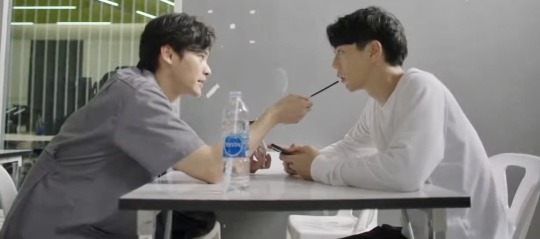
Ongoing Series - Thai
Lovely Writer Ep 5 - a little slow this week, but at least Gene finally flirted back, and very cute flirting it was, too. Also we got Aey’s motivation, background, and love interest. Thank goodness for that.
Brothers Ep 8 - still pants, what can I say? Clearly I am a BL masochist. Very embarrassing for everyone concerned.
1000 Stars Ep 9 - the conflict over Tian’s father was REALLY well done. The plot of this drama is excellent, the leads are great together, and yes I totally cried. What, you didn’t?

Ongoing Series - Not Thai
Word of Honor (China) Ep 16-18 - big battle fighty fighty stabby stabby. Ep 17 switches to “this drama isn’t big enough for two chaotic-neutral godlings!” So what do they do? Drink together and bicker... A LOT. Then in Ep 18 we all get the dubious joy of really freaky puppets. (I HATE puppets.) Also how is China letting this be so SO VERY VERY GAY?
Also, I wanna walk through the forest wearing a smanshy purple robe and waving a big fuck-off white fan around simply because I’m a pretentious fuss monger. And frankly, I feel like this is an achievable life goal for me.
We Best Love 2 (Taiwan) Ep 4 - not gonna lie, this is looking to be one of my top 3 BLs of 2021. It’s SO GOOD. Big bonus to this ep for treating stalker behavior like the mental illness it is and not as some dumb representation of enduring love.
The Most Peaceful Place is My Place (Vietnam) Ep 1 - finally dropped (find it under NƠI BÌNH YÊN NHẤT LÀ VỀ BÊN EM on O2′s channel). It’s got actors already comfortable with BL and looks pretty good so far. An angry tsundere uke reunited with his ex, a stoic chef, giving us lots of snap, crackle, and pop out the gate.
Dear Uranus (Taiwan GL) Ep 2 - I want to love it, but it is just moving too fast. There’s not enough character dev and then they’re throwing flashbacks in? It feels like a treatment rather than a show, and a rushed treatment at that. Bummer.
HIStory 4: Close To You (Taiwan) Ep 2 (AKA Ep 3-4) - let the cheesy popcorn continue! Idiot remains an idiot; ingenue remains an ice queen; nice gay guy remains nice and gay; obsessive stalker brother is getting ever more whackadoddle. Of course these last two have the best chemistry. (It’s caregiver codependency and the salvation trope. We got us a Leo/Fiat situation going on.) Plus lots of classic BL tropes because OF COURSE there are lots of tropes.
Occasionally, I am tempted to argue that shows like H4 or Cherry Magic or Ossan’s Love aren’t technically BL because of the office setting and age of the protags - but then they all behave like high school students anyway, so *shrug*
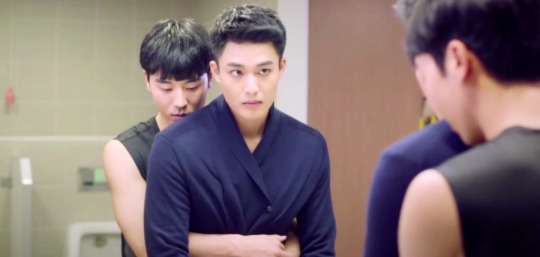
Stand Alones
Cute little Taiwanese micro BL Friend or Lover dropped, about bisexual realization within a friendship group. Normally these are too short for me, but this one did pretty good with its 15 minutes of charm, plus it’s abad boy + shy softy pairing.
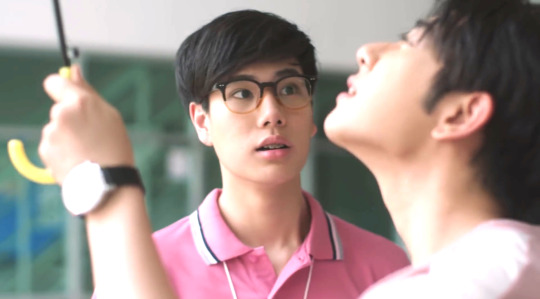
Breaking News - Thai BL
Fish Upon the Sky released its actual trailer. The upside-down kiss is gone, which makes everyone sad, and it seems far less rivals to lovers than the first iteration, which makes ME sad. But it still looks good and a more classic BL than GMMTV has given us in a while. New trailer focused more on the makeover trope and they’ve upped Mix’s role (the object of everyone’s affection) now that he’s proved himself. (Or they are using him more to carry the trailer since he has a fan base form 1k*). Starts April 9 on GMMTV in 1K*’s time slot, probably with a 10 ep run.
2gether the movie is apparently coming April 22 to Thai theaters. F4 Thailand must be having issues or GMMTV just wants to milk the BrightWin cash cow. It’s rumored to be a combination of 2gehter + Still 2gether with some extra scenes and ending. Also, one assumes a lot will be cut out, if it’s movie length.
Call It What You Want released its updated trailer. If anything, it looks more scary than before. What are we in for? April 9th.
Nitiman got a release date, May 7 on One31.
I Told Sunset About You 2 got an updated release date of May 27 on LineTV.
Second Chance the series is coming to LineTV on March 29. I don’t know much about this one. Tons of familiar faces (mostly TharnType side dishes) and some nice looking new talent but a dearth of eng subs. I think it may take on Brothers’ time slot. Line did eng subs for Brothers so maybe they will do 2nd Chance too?
Close Friend the series is coming April 22. This is a combination of 6 couples with 6 story arcs as music videos (maybe)? It’s an epic fan service with familiar faces like OhmFluke (UWMA), MaxNat (LBC also in Y-Destiny), YoonLay (YYY also in Y-Destiny), KimCop (GenY), and JaFirst (TT2).
Y-Destiny starts March 30, and has starting dropping couple’s trailers. I’m still suspicious given the director but it seems like there is plot (or plots) and a theme. Looks to be a series of 7 single ep vignettes (amended, see comments, might be 2 eps each for 14 eps total), different couple each time, some with supernatural elements, all with decent chemistry and acting chops.
Sun MaxNat’s tutor/student arc
Mon jaded rich kid meets poor innocent
Tues sports romance enemies to lovers
Weds the messy realistic actual dating one
Thurs hot ghost boyfriend (sad)
Fri YoonLayPerth coping with loss and finding new love (sad). This one will all rest on Lay's acting so we know it’s in safe hands. Our boy is going to KILL it.
Sat time-slip memory loss reunion romance
I’m thinking we can’t expect any of these to end happy or be classic BL. They’re gonna be more slice of life-ish.
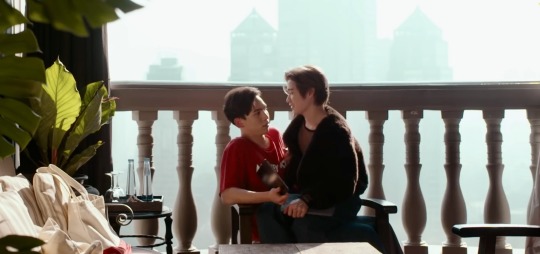
Gossip - BL Outside of Thailand
Scholar Ryu’s Wedding Ceremony AKA Nobleman Ryu’s Wedding (Korean historical BL) got a legit teaser (eng sub here). @curriculumvtae reports that it’s releasing April 15th on WeTV (Philippines & Thailand) and Idol Romance (South Korea), while Will of Thai Bl says it’ll be on Viki too. It’s a short run of 8 ep built on a fake relationship trope (arranged marriage variant):
Ryu Ho Seon’s (Kang In Soo from You Wish) arranged marriage turns out to be with his expected bride’s brother, Choi Ki Wan (Lee Se Jin from Mr Heart). Ryu tries to undo the marriage, but his ill mother opposes this saying the scandal would be too much. Meanwhile, Kim Tae Hyeong (Jang Eui Soo from Where Your Eyes Linger), a senior at Ryu’s school, comes to congratulate him and falls in love with Choi. Then one day, the original bride disappears.
Okay it seems a bit twisty turny for ONLY 8 EPS, but oh my goodness how excited are we? Our first intentional historical BL out of Korea!

We already knew Hong Kong was doing a remake of Japan’s Ossan’s Love under the same name (not my favorite Japanese BL but so very popular) but it’s now reported to be coming to Viu in June. Who knows how the CFA will take it. Depends on whether Hong Kong bows before the NO GAY KISSES regs or if they are going to use this as a political nose thumb... things could get cray with this puppy (the original has several kisses and s shower scene). Are we back in Addicted territory only with added comedy and civil unrest?
Speaking of Japan, Absolute BL (AKA Zettai BL ni Naru Sekai vs Zettai BL ni Naritakunai Otoko) dropped sooner than anyone thought, March 27. But being Japanese who knows how/when/if we get subs. Protag finds himself trapped in a world of BL, but being straight he fights against any hot guy that draws near, but the whole world (literally) is conspiring against him. It’s a parody adapted from a yoai.
What with Absolute BL from Japan plus Lovely Writer and Call it What You Want from Thailand, is 2021 the year of BL being ultra self referential? Sure feels like it.

In Case You Missed It
Faded a gay micro film from Taiwan from 2017 deals with parental acceptance and serves up a ton of BL tropes (piggyback, forehead kiss, etc). I’m pretty sure this was a propaganda piece for legalization of gay marriage, and it’s an interesting nugget of BL history as a result. Yes, it ends happy. It’s cute.
Next Week Looks Like This:
Some shows may be listed a day later than actual air date for accessibility reasons.
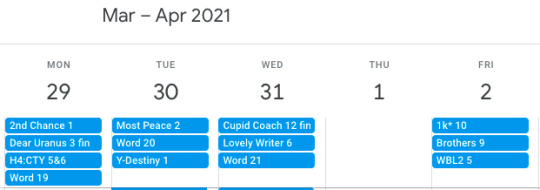
Upcoming 2021 BL master post here.
Links to watch are provided when possible, ask in a comment if I missed something.
Man there’s a lot going on right now! Spring has sprung... I suppose.
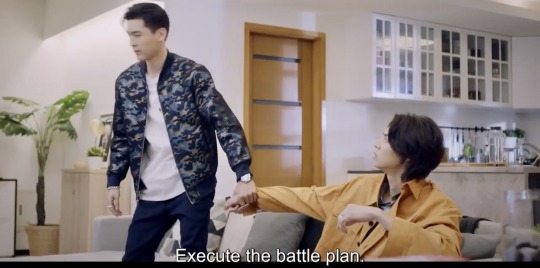
P.S. I cannot believe I missed Absolute BL as a blog name. Numbnuts = me.
#asian bl#asianbl#thai bl#thaibl#brothers the series#lovely writer#1000 stars#a tale of thousand stars#We Best Love: Fighting Mr.2nd#taiwanese bl#taiwan drama#history 4: close to you#dear uranus#taiwanese GL#asian gl#second chance the series#2gether the movie#y-destiny#friend or lover#Fish Upon The Sky#Call It What You Want#close friend the series#i told the sunset about you 2#faded short#oassan's love#japanese bl#absolute bl#Nobleman Ryu’s Wedding#korean bl#nitiman
354 notes
·
View notes
Text
TerraMythos 2021 Reading Challenge - Book 3 of 26

Title: Acceptance (The Southern Reach #3) (2014) - REREAD
Author: Jeff VanderMeer
Genre/Tags: Horror, Science Fiction, Ecological Horror, Cosmic Horror, Weird, First-Person, Second-Person, Third-Person, Unreliable Narrator, Female Protagonists, LGBT Protagonist
Rating: 10/10
Date Began: 1/11/2021
Date Finished: 1/20/2021
Area X, a self-aware wilderness along the coast, has existed for decades behind a mysterious border. The landscape itself annihilates humans and repurposes them for its own ends. Hundreds of people have died attempting to uncover its secrets. But no one has yet discovered its origins or true purpose.
Now, Area X has spread past its former borders, perhaps to the entire world. Acceptance follows several key figures through the history of Area X, and their attempts to fight against an impossible threat.
You feel numb and you feel broken, but there’s a strange relief mixed in with the regret: to come such a long way, to come to a halt here, without knowing how it will turn out, and yet... to rest. To come to rest. Finally. All your plans back at the Southern Reach, the agonizing and constant fear of failure or worse, the price of that... all of it leaking out into the sand beside you in gritty red pearls.
Full review, major spoilers, and content warning(s) under the cut.
Content warnings for the book: Extreme body horror, altered states of mind, and psychological manipulation, including hypnosis. Several characters lose their sanity, and you see it happen in real time from their perspective. Intentional self-harm/mutilation as a plot point. Some violence and gore. There are brief references to animal abuse and terminal cancer. Not many happy endings in this one.
This review contains major series spoilers. It’s also super long, as the book covers a lot of material.
Acceptance is the most narratively ambitious book in the Southern Reach trilogy. While Annihilation and Authority feature a single protagonist/perspective, this one has four rotating POVs and one guest narrator partway through the book. It also covers a broader timeline than previous entries, from the origins of Area X 30-ish years ago to the ongoing present-day apocalypse. Acceptance is one of the few books I've read that utilizes first-, second-, AND third-person narration in a single volume, adopting whichever one makes the most sense for the character and their situation
While this sounds complicated, it's basically just a way to tell four different stories at the same time. VanderMeer also uses each storyline to address the major questions of the series. How did Area X come to be? What happened to the biologist? What was the former director of the Southern Reach trying to accomplish? And perhaps most pressing-- what is the fate of the world now that Area X has spread? Not everything is resolved, but it's definitely a conclusion.
The stories have some unifying connections, containing similar themes and callbacks/references to each other. However, for the purposes of this review I will be looking at each story and protagonist individually.
First up is Saul Evans the lighthouse keeper. He's been mentioned before, but never in much detail. Going in, we know a few things-- (1) he knew the director/Cynthia when she was a child and (2) something happened to him that turned him into the Crawler, the eldritch creature which writes the sermon on the walls of the tower in Area X. In Acceptance, we learn he's a former preacher who had a crisis of faith and left his old life, taking up the role of lighthouse keeper on the forgotten coast. It's implied this is partially due to him realizing he's gay and fleeing the resulting homophobic fallout. His past vocation explains the elevated, sermonic language of the words in the tower.
From the onset Saul is an intensely likeable character. He's trying to build a happier and more genuine life for himself. This part probably takes place during the 70s or 80s, but he's cautiously optimistic about his new life with a local fisherman named Charlie. He also forms an unlikely friendship with Gloria (aka Cynthia), a local kid who loves exploring the coast. However, he is tormented by the "Séance and Science Brigade", a shady organization that investigates/worships(?) paranormal phenomena. They sabotage the lighthouse beacon, which we learned in Authority is a marvelous piece of technology with a mysterious history. Shortly after, Saul accidentally absorbs a fragment of the beacon into himself, and shit goes downhill real fast.
While the catalyst of Area X may seem a little weird, the reader can piece together that part of the beacon has extraterrestrial origins, and Saul unintentionally activates part of it. The gradual shift from a normal life to something deeply unsettling has its appeal. I especially like seeing his logs/journal entries and how they devolve as proto-Area X overtakes his mind. The disturbing bar scene near the end is great as well. We know going in that this story has a bad ending (from a human perspective), but learning specifics about Saul as a person gives this more impact. Saul's is a sad tale of a man who wants to make a better life for himself and gets screwed over by bad luck.
Cynthia/Gloria/the former director is the next perspective character. In Annihilation she serves as the antagonist, but in Authority we learn it isn't that simple. She had ulterior motives, handpicking the biologist for the expedition in order to use her as a weapon against Area X. And, of course, we learn she was the little girl in that old picture of Saul, which means she probably grew up there before the border came down.
This part opens with Cynthia/Gloria's death as "the psychologist" in Annihilation, but told from her perspective. From there, the pacing is a little slow, in similar style to Authority. We learn how Cynthia lived her daily life, how she infiltrated the Southern Reach, and her interpersonal relationships with Grace, Whitby, and Lowry. However, her storyline ramps up when detailing Area X and the lead up to twelfth expedition. Lots of old scenes/dynamics from Annihilation hit different with the new context. Especially interesting is the interview between Cynthia and the biologist; turns out there was a lot more context that the biologist obscured in her story. On some level we already knew she was an unreliable narrator, but it's fun to have it pop up again in a different book entirely.
I admire how VanderMeer makes someone who comes off as a throwaway villain into the one of the most complex, important characters in the series. This part is also really cool as it's written in second-person perspective, and the story justification for this (Area X examining her memories) is neat. While I like Cynthia's characterization in this part, the additional bits in Saul's story and his interactions with Gloria add helpful context and emotional impact. The end of the book being her letter to Saul is so damn sad.
The third main storyline follows Control and Ghost Bird in the "current" timeline-- exploring Area X in the immediate fallout of Authority. I love this part for several reasons. The contrast between the two leads and how they perceive themselves, Area X, and the current situation is great. Control is very much losing control, feeling "the brightness" taking over (a callback to Annihilation). Meanwhile, Ghost Bird is in her element, seeing and experiencing things the regular human characters do not. There's the sense that she's truly something "new" in terms of both humanity and Area X.
We also learn a ton of stuff about Area X that is hinted in earlier volumes but confirmed in Acceptance. (MAJOR SPOILERS) The first is that Area X isn't on Earth at all; something briefly hinted at in Annihilation, when the biologist doesn't recognize the stars in the sky. Instead it mimics Earth, or something representative of it. The second big thing is that time works differently here. The uncanny state of decay noted in earlier books isn't actually a direct result of Area X. It's just the passage of time, because way more time passes in Area X compared to the "real" world.
The guest narrator/story is told within the Control/Ghost Bird storyline. The two meet up with Grace, who has managed to survive the Area X attack on the Southern Reach. She took shelter on the mysterious northern island and discovered an old journal written by... the biologist from Annihilation, which details what happened to her over the last THIRTY YEARS (yeah, the time thing) until she finally decided to give into Area X.
This section is sobering and sad; basically a glimpse at how the biologist's isolation slowly made her go mad. She finds an owl (hello cover) that she believes is her husband post Area X conversion and the two live together for decades. When it dies, the biologist loses the will to keep fighting Area X. It's ambiguous if the owl really is her husband, or if she's just projecting, but her heartbreak at the end is probably the strongest emotion she shows in the series. But what is interesting about this part is it confirms a cool detail. Injury and pain can halt the progression of "the brightness" within someone. Which is how the biologist managed to survive 30 years, how Grace survived what turns out to be 3 years, and so on. Even more interesting, when someone DOES finally succumb after warding off the brightness this way, they turn into something more strange and alien. Hence the moaning creature, and Saul/the Crawler. It's also probably why some creatures have incongruencies, like the dolphins with human eyes.
The biologist? She transformed into a giant, oceanic eldritch abomination COVERED in eyes. Just primo aesthetic. We get to see her from both Ghost Bird and Control's perspectives. Ghost Bird feels solidarity and a sort of euphoria meeting her alternate self. Control... basically breaks in the face of something like that, full cosmic horror style. Again, the contrast here is really appealing to me.
Both of their story arcs end in a way that is narratively satisfying, though the ending is open. The future seems hopeful in a bittersweet way, but presumably Area X has destroyed humanity as we know it. Whether that's a good or bad thing depends on your perspective and is a central thesis of the series.
So, I said I'd discuss how this series approaches aliens. While there's an appeal to anthropomorphic alien species one can talk to and communicate with, I think an "unknowable" perspective is more realistic. After all, who's to say alien life formed under similar conditions or has any resemblance to our own? The extraterrestrial element in The Southern Reach is very much this type. But it's a fine line to walk in fiction, because handwaving the weird alien stuff as impossible to comprehend (and thus conveniently ducking any responsibility for explaining it) is lazy writing when done wrong.
The thing I find interesting about this series is the human characters understand lots of the what of the alien elements, but not the why. For example, Area X transforms humans into various plants and animals. We know it instills a sense of "brightness" in humans exposed for too long, which encourages assimilation into itself. Humans infected in this way, even if horrified or resistant, have thoughts of this being inevitable, even a good thing. The biologist takes samples in Annihilation and finds several plants and animals have human cells. Control logically knows what Area X does to people, but he is ultimately helpless to resist the process when he experiences it firsthand.
As for the why of it all... we don't really know! There's multiple ideas presented throughout the story. Ghost Bird probably gets closest to the "truth"; that Area X is part of a machine organism from a dead alien civilization, and that it has a bizarre effect on Earth's biology based on its now defunct programming. Other worlds would have their own Area Xes based on this idea, as it's implied the Earth version is just one piece of many. But it's worth noting that Ghost Bird is a creation of Area X and sees things differently than the other characters. Unreliable narration is ironically consistent through the series. So it's hard to say if this is true or not; perhaps it's silly to think any explanation would be understandable to a human mind. Obsession with finding the answer is a recurring theme that drives characters insane. I think this is an interesting compromise when discussing the unknowable; to have some facts and theories but not necessarily a concrete answer.
If I have a criticism for this book, it's the role of the "Séance and Science Brigade", especially in Saul's storyline. While they're set up earlier in the series, we only really see them in this book. Our limited perspective via Saul leaves a lot of ambiguity as to their purpose, function, and goals. There's an implication that Control's family influenced the organization's decision to sabotage the beacon and create Area X. But I consider the subplot with Control's mom/grandfather to be one of the weaker ones in the series, and this book didn't help. The S&SB comes off as campy and ineffectual, which is perhaps intentional? But since they're narratively the fanatics who caused Area X to happen, I really wish they felt more sinister and impactful. There's some attempt to make them scary, but it's not very convincing when compared to Area X. Kind of like a Saturday morning cartoon villain vs the unknowable cosmic horror of the universe. This is a nitpick, though.
While rereading the series, I discovered there's a planned fourth book which may or may not star a minor character from Saul's story. I'm interested to see what else there is to explore about Area X and the Southern Reach. As it stands, I still really like this series. Between the horror and general weirdness, it's not for everyone, but it sure does appeal to me. I think this is one of those series that you'll either adore or hate. Obviously I recommend it.
14 notes
·
View notes
Text
Full-Art Lands Pt.2
Hello internet persons, this is Rad from 2/9/21 speaking. I am tired from an early early shift at work, and also just got the first vaccine dose, so I’m going to be posting these words written on Monday when I anticipated exactly this level of exhaustion. This might defeat the purpose of “a blog post a day”, but its hardly the first time I’ve done it and also I think I have a pretty solid excuse.

Anyway. This is a continuation of a discussion of every Full-Art Basic Land set in Magic: The Gathering, starting now with Modern Horizons. It counts!
Modern Horizons

Kind of cheating, because technically the Snow-Covered Lands are different cards, but unless you’re building around them (or a card like Extraplanar Lens) then they’re functionally pretty much the same. These are also literally the only Full-Art Snows, so if you’re running those then this is basically your only pimp option.
Ultimately these are kind of held back by the fact that, well, everything has to be blanketed in snow. There’s some interesting blues going along with the Plains and Mountain, and there’s some fun sky colours, but the remainder is left a little bland.
I currently believe these are worth investing in, for what it’s worth. Both Full-Art Lands and Snow Basics always go up eventually, slowly, over time, and these are still less than a dollar each for now.
Secret Lair: Artist Series: Seb McKinnon

This one is kind of a special case, because there’s just a Swamp. And there are technically two of them, but one is just an older version of the art. So I wasn’t sure whether or not to count these.
Because of these limitations, it’s hard to recommend these unless you have a lot of money and also a mono-black deck. They look great, matching Seb’s excellent style from the other cards in the drop, but it’s a bit of an awkward one. That said, I just have these sitting around, seeing as I got this drop just for the Damnation, so…might as well, I guess?
Theros: Beyond Death

Much like Amonkhet/Hour of Devastation, this set has one full-art mixed in with several regular basics. The difference is that these are representative of Nyx, the world of Theros’s gods, with its symbolic and nebulaic art.
There’s no real getting over the part where these just look like the Basic Energy cards from the Pokemon Trading Card Game. Considering WoTC’s hand in designing that game, and that the two are equivalent because, well, WotC designed them that way, it’s a fair comparison. But I don’t think this is why these ones aren’t as good as other full-arts. I have two main issues with these lands, and the first is that, well, there’s no land on them. For a set themed around a specific plane, one would expect that plane to be represented in the art, and Nyx does have actual landscapes on it. I get the space-themed design, but they could have been up in the sky above an actual Mountain or whatnot.
The other is the missed opportunity of these being Nebulae. That’s a fine enough design choice, though the symbology is a bit hammered in, but like. In a set based on Ancient Greece and its astronomical focus, with Gods that look like and are represented by constellations, with a mechanic called Constellation, they probably should have just been constellations. It would have made for a more subtle, less, well, Pokemon look, as well.
Unsanctioned
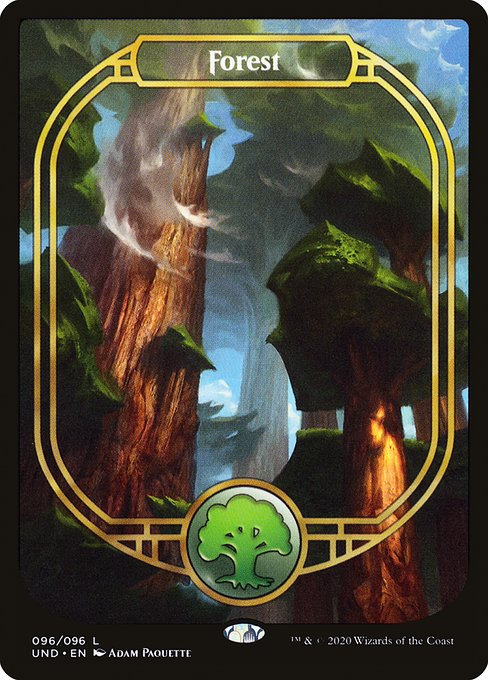
New Un-Set, new basics. These ones are kind of a hybrid between the Unglued and Unstable ones, with that golden frame and almost borderless design. I’m actually not sure how I feel about these, since while the frame looks nice, it’s also kind of pointless, and the texturing on the mana symbols is a little weird. I don’t like how smooth and reflective they are.
The art is at least still excellent. Not John Avon, but Adam Paquette does a great job distinguishing himself, less realistic but still believable places that feel fantasy. I actually feel like Unsanctioned was overall a miss, especially since each box came with like 2 of each of these basics, but that’s not something I’m holding against them.
Secret Lair: The Godzilla Lands
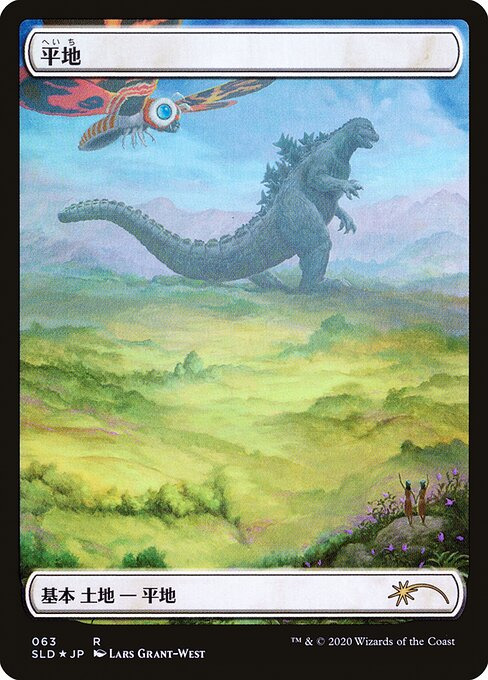
Secret Lair has been an opportunity for WotC’s designers to experiment a lot with card frames, though this set of basics doesn’t quite represent that. I’m not sure how well this one did, to be honest, though they did make future basic-only SLs, so fair enough I guess.
So, do you like Godzilla? Because he’s on all of these, along with some other Kaiju from the greater series canon. It’s kind of a little distracting, because the landscapes are otherwise gorgeous. Ironically, though, Godzilla himself is kind of being a scale-reptile in these pieces, giving a sense for just how big that mountain is, or how far away the “camera” is from the ground.
The only Island I see in that Island is Godzilla himself, though.
Double Masters

These are just a set of reprints from Unhinged and Battle for Zendikar, but in a more borderless style. I’m honestly not sure how I feel about the Unhinged arts being blown up like this. But this is a reprint set, and these are honestly kind of boring, so eh.
Zendikar Rising
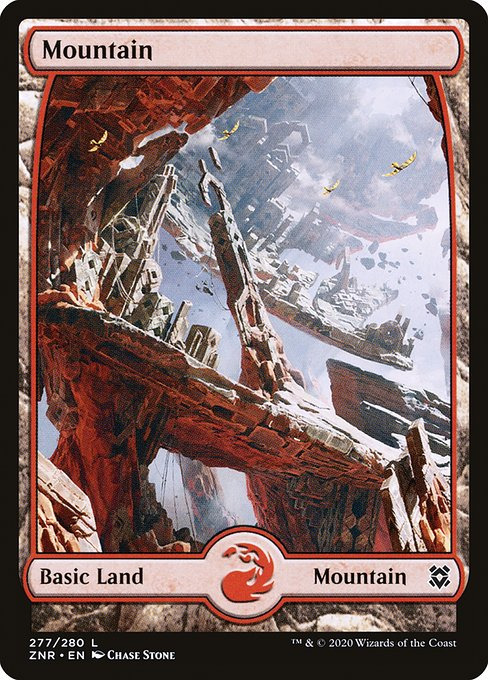
Another Zendikar more lands etc. etc. you get the idea. Like the title suggests, this iteration of the plane has a lot of vertical exploration in its flavour, and the new basics reflect this. Especially in the Plains, Islands, and Mountains, that sense of adventure and traversal is back from the first Zendikar set.
Interestingly, this one doesn’t have any reprinted arts, unlike Battle for Zendikar, even though there’s only 3 of each land here. There’s probably something to be said about distancing this set from BFZ- that set faced a fair bit of backlash, and it is thematically very different from ZNR. There’s also the conspicuous absence of the Hedrons, apparently having been replaced in art and in flavour by the Skyclaves. No, I still don’t know what those actually are supposed to be.
At the end of the day, these cards do end up making Zendikar feel like it’s lost its edge a little. They’re just a bit too bright and friendly for my liking, even with the inclement conditions in some of the images. I think it literally just might be the clear, bright skies in this one.
Secret Lair: The Unfathomable Crushing Brutality of Basic Lands
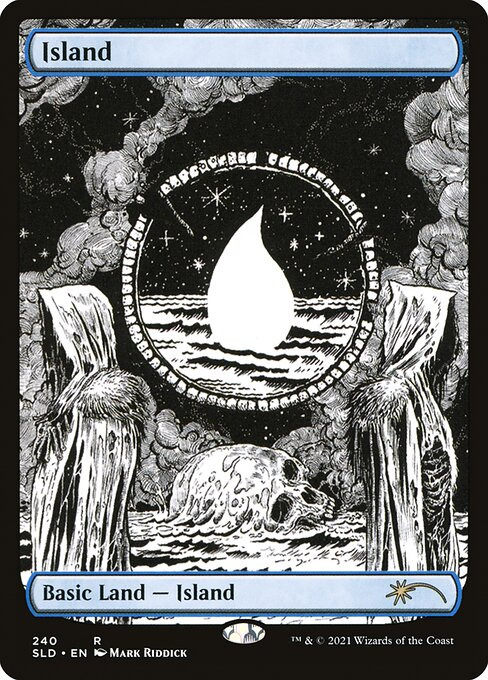
Yeah these are about as edgy as the name suggests. Monochromatic and striking, this set of basic’s iconography is much more evocative than literal, the mood of the colours in their themes, captured largely without them.
It does greatly amuse me that literally all of these arts contains skulls. Talk about gothic. I like these a lot better than the Theros: Beyond Death lands, despite the similarities- Particularly, that the mana symbols aren’t literally just the standard ones- arguably the Island is, but it at least is in the form of negative space.
I can’t get over how thematic these are. Plains embodies community with its weapons and runes and roots, and the human face on the Sun icon. Island represents the vastness of knowledge with its endless waters and starred skies. Swamp is death, skeletons mired in the depths of the surroundings. Mountain is fire, bold and unflinching, while Forest’s gnarled branches running through the skull shows the unflinching nature of, well, nature. They’re all so utterly sick.
Innistrad: Midnight Hunt
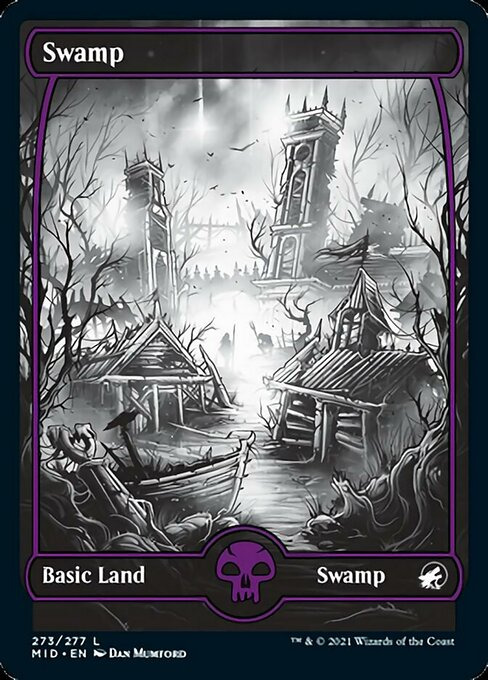
The most recent addition to this list, and one you actually can’t get yet. I think the frames on these being so thin is excellent, since it means they aren’t taking away from the spectacle of the art- not to mention the monochrome of the border and art.
These pieces are magnificent gothic landscapes, the kind you’d expect to see illustrated on the inside cover of Frankenstein or a Lovecraft story. Each and every one of them is ominous in its own special way, with the Swamp that’s a ruined river town to the rugged cliffside path of (presumably) Geier Reach. And the Island with the waves crashing across the cliffs is utterly gorgeous.
Obviously we haven’t seen these in paper quite yet. And the monochrome may make it difficult to tell them apart at a glance. But these are sacrifices I am willing to make for the sake of style.
This is the sum total of all the FABs. For now. Something I didn’t quite realise when writing this was the sheer number of options for this kind of pimping, and how much they’ve ramped up in production over the last few years. Much like with the increase in cards in general, I suppose, as well as premium product versions like the Secret Lairs. I would be genuinely shocked if the game ever exclusively started using Full-Arts, but I’d also not be surprised if we saw them yearly at the longest.
Either way, I’m sticking with my BfZ lands, because those are the ones I already have!
1 note
·
View note
Text
DISCO S3 NYCC TRAILER ANALYSIS!!!!!!!
sMESA BACK!!!!!!!!!!!!!!!!!!!!!!!!!!!
And boy oh boy was Saturday, October 5 such a good Trek news day!!!!!!!!!!!!!
so....let’s get back to some good ole analysis of the teaser trailer for Discovery Season 3, still likely to be about a year away before we officially see it
Trailer begins with our queen Michael landing in the future


that is a lot of dirt you might say, it’s like she landed near volcano or something

ohhhhh a look into her gear - so it looks like her science division badge, a phaser, and a communicator maybe, the black one that looks like a phone and has the Starfleet delta decal on it, and there’s some other equipment that I don’t know what they are
then we hear Michael’s voice saying “I’ve spent a year searching for that domino that tipped over and started all of this”
and by this, I think she means she spent a year trying to find the cause of why the Federation has “fallen” in a sense, as this would tie into what looks to be the theme of the season by the looks of the rest of the trailer
accompanying her voiceover, we see the following images
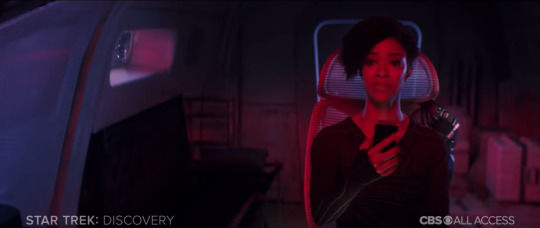


we not only see Michael’s changing hairstyle, but also how her mood has changed, going from worry and fear to almost resigned and ready for whatever that’s coming - also we see that she did seem to pick up more equipment or other objects throughout this one year period as indicated by the growing piles behind her
it is confirmed that Michael and the Disco crew did not land in the future together, so it looks like Michael arrived first, and the Disco crew lands one year after Michael’s arrival

here we see Michael with our new series regular David Ajala who is playing a character named Cleveland “Book” Booker, from the looks of this scene, Michael runs into him at some point and they seem to be avoiding someone else or being chased by someone else and are trying to run away and hide
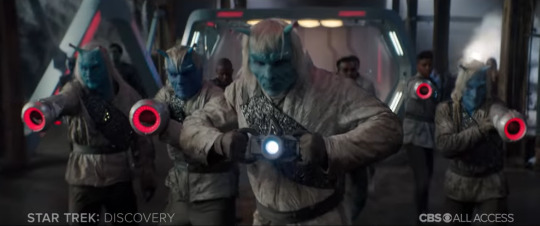
and it seems Michael and Book are running away from some Andorians with very interesting weapons, we also see some humans behind the Andorians - could this be some remnant of a Starfleet/Federation?
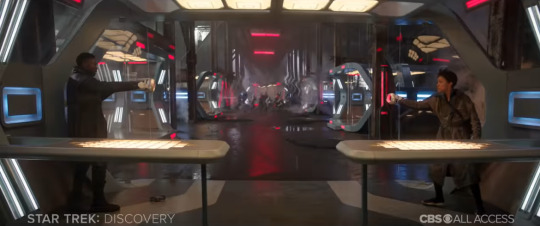


some sort of pulse weapon is released and Michael and Book are knocked flying and glass is breaking

Michael and Book are walking across some landscape and we got two planets in the sky - I’m not sure what this planet is or if this is even the same planet where Michael landed, but we do know from the panels and interviews that Michael and the crew did not land at Terralysium as they had hoped
Book asks Michael, “You believe in ghosts?”

Michael replies, “What does that mean?”

Book: “That badge on your shirt.”

the look on Michael’s face says it all - she realizes what he means - the Federation, Starfleet...they’re basically ghosts, something that doesn’t exist anymore

Saru and Tilly are the next shot that we see, the doors look to be the Disco bay area? Maybe they are getting ready to take a shuttle and go somewhere? They certainly looked to be dressed for it.
next we hear a man’s voiceover saying “I watch this office everyday, believing that my hope was not in vain...”
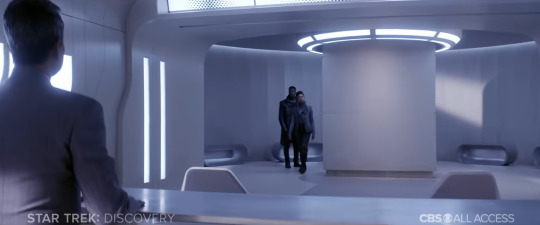
so Michael and Book are at this office and meeting the man speaking the voiceover, I don’t know if Book brought Michael there or if something else brought them there - like perhaps the people that were chasing them got them here?
and this man, I don’t know if he’s a Federation government member? or maybe this is a museum? or a believer of Federation ideals? or perhaps he is someone who is the descendant of a character we know from Season 1 and 2 (maybe like Ash Tyler) who has been told to wait for Michael and find her if she does appear in the future? that might be a bit of a stretch but it could be an easy way to explain his devotion and belief?
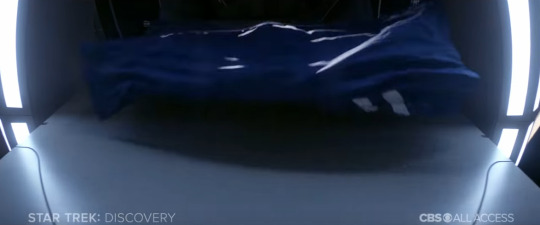

we see the flag of the Federation, interestingly this one has only 6 stars
just to compare it with, this is the usual flag of the Federation that we see

so at this point, it is looking like something caused the Federation to break up and become fractured? those 6 stars perhaps represents the 6 species/planets that are still standing together?
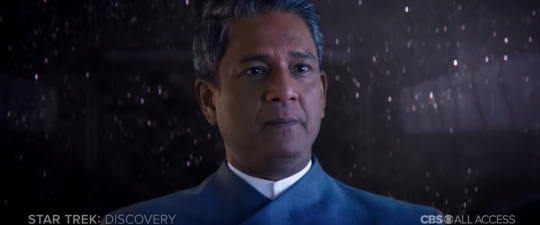
the man’s voiceover contines in this next scene, “...and that hope is you, Commander Burnham”
the fact that he knows her name is why I am inclined to believe that he is the descendant of someone who knows Michael and has been told to one day expect her

this next reaction shot of Michael’s face is not related to the scene before, as we see by the change in Michael’s hair, this shot is a year after the scene of Michael meeting the man above - this shot is likely Michael’s reaction to finding out that the Discovery crew has finally made it through

explicit confirmation of how many years we jumped into the future - so since Disco Season 2 mostly took place in 2257, this means that Michael lands in 3187 and one year later is 3188, when the Discovery arrives

at the panel, it was confirmed also that we would explore more of the Trill, and we see that in the trailer - the two people in red are likely Trills, the person in the foreground doesn’t look to be Michael, but it might be her, and the pool is where the symbionts are
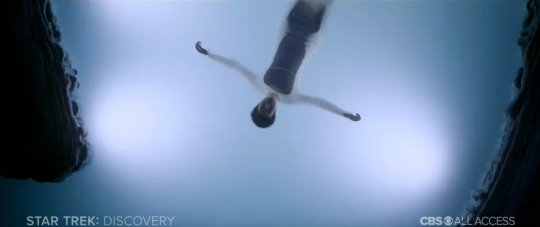
this could be Michael in the pool? or it could perhaps be another character who becomes a host? we have heard rumors that Disco Season 3 is possibly bringing in a nonbinary character, so this may be that person as this looks like the actor I was informed they had cast
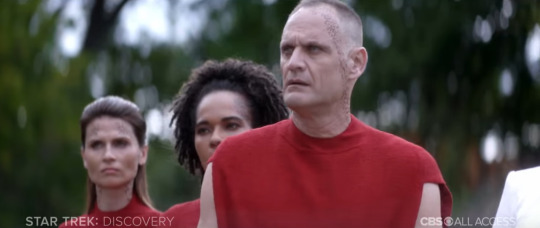
now these are definitely Trills, though it might be unlikely we will see the Dax symbiont from DS9 around in season 3, since I’m not sure the symbiont would be able to live into the 32nd century

and there’s Discovery!!!!!

REUNIONS!!!?!???!?!!
Michael has found her Disco family!

A shot of Detmer and Owosekun.

Culber looks rather concerned


some sort of confrontation is happening in the spore drive room, there is at least one person holding weapons, some non-Disco crew people, maybe someone after the spore drive? it was noted that the drive may become a target
we do see Stamets and Tilly in the top right corner, but the person to their left kinda looks like Stamets?

Stamets and Tilly both look very unhappy and alarmed at the same time.

Book and Michael are fighting on that planet we saw them walking across earlier, and it looks like those Andorians or whoever was chasing them has caught up to them
the person Michael is fighting doesn’t look like an Andorian, but Book is definitely fighting an Andorian

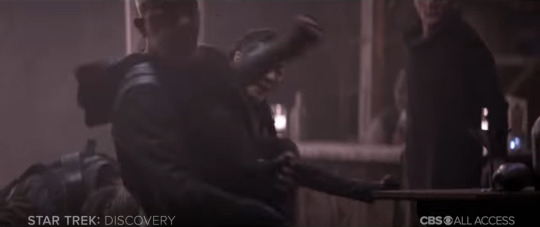
and here we see Georgiou getting into some fights as well, and we see Saru behind her - it looks like wherever Saru and Tilly were going, Georgiou went with them as well

this character here I believe is the nonbinary character they had rumored to have cast, and this might also be the same character we see go into the Trill pool and possibly be joined with a symbiont?

now this shot....ohhhhhhh
so from left to right, we got Andorian, a species that I cannot really be sure of, Human, Cardassian(?), Lurian, and another Andorian
they are part of the same group that we saw earlier in the trailer chasing Book and Michael

Book and Michael are booking it (sorry I couldn’t resist)

so through the last few scenes, we have been hearing Saru’s voice saying “This ship bears the name Discovery. She has carried us into the future, and it will be our privilege to make that future bright.”
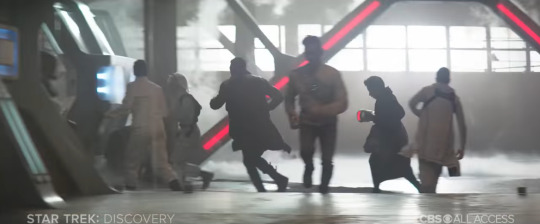
Book and Michael are sure not skipping leg day in this trailer - this looks like some sort of science facility?
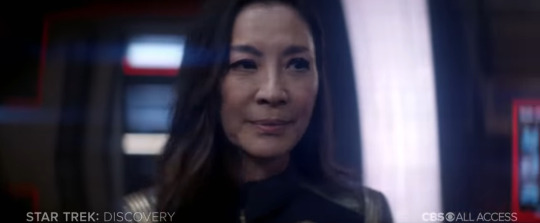
next shot is an interesting one - this could either be a flashback to Prime Georgiou, or this is Mirror Georgiou pretending to be Prime for some undercover sort of mission?
either way, she says “Let’s see how this plays out, shall we?”
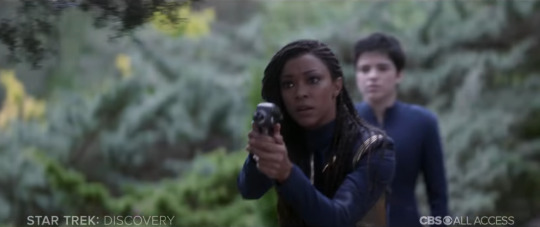
Michael pointing a phaser at someone, now judging by her hair, this is one year after she landed in the future, and the person behind her is likely that nonbinary character (who I really need to know the name of so I can use their name properly)
also interesting to note about her uniform - the color stripes don’t look silver

and a close up look on her badge....that’s the command division badge
now Michael’s uniform is missing the stripes across the shoulders that indicate a captain, but the change in color and badge looks like Michael is officially moving from science division into the command track and she will be wearing gold and not silver anymore

something is happening on Discovery and Owosekun is getting shaken around

Georgiou killing some folks
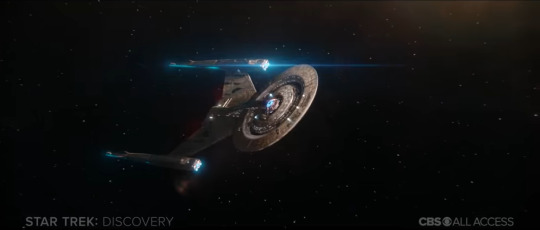
Discovery flying

and finally, we hear the man say “Where will you go?”
to which Michael answers, “Wherever the answers are.”
but look at the way they are holding hands, you do not hold hands with strangers like that, I mean, short of this guy being a fan, this sort of familiarity speaks to a deeper connection, which just goes to further add to my suspicion that this character is likely a Ash Tyler descendant of some sort, or a descendant of someone who once knew Michael and has been waiting for her to appear in the future because they were told to wait for her by someone who had knowledge that Discovery went into the future
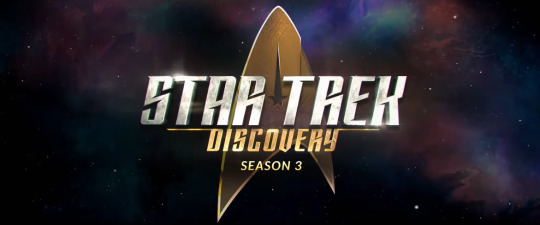
this logo color feels happier and brighter somehow

so there it is! the trailer giving us the first look into season 3! SO MANY POSSIBILITIES!!!!!
and I’m sure before its 2020 release, we will see at least one or two more trailers so we can have more of an idea, but I am so excited to see Discovery boldly go off into the future!!!!!!!!
whatever is happening this season, it’s looking like Discovery is going to be leading the way to rebuild a possibly fallen or broken Federation and restore it to the ideals that it once stood for! this is an interesting narrative, especially when compared to some of the themes we are seeing with Picard’s story and going rogue because the Federation won’t do the right thing to help.
I’ve said in other places already but it looks like Disco and Picard are both telling this overarching Federation narrative but going at it from two opposite ends with Picard detailing the gradual decline of the Federation while Disco is giving it a rebirth.
BRING ON SEASON 3!!!!! YESSSSSSSSSSSSSSSSSSSSSSSSS!!
#star trek discovery#star trek discovery season 3#disco spoilers#discovery spoilers#star trek#star trek discovery speculations#michael burnham#saru#sylvia tilly#paul stamets#hugh culber#cleveland booker#mirror georgiou#joann owosekun#keyla detmer
133 notes
·
View notes
Text
KH: MOM Review (Gameplay)
Every Kingdom Hearts game feels different. It's always innovating and always adding new types of gameplay. This is no exception. Rhythm minigames are no stranger to the Kingdom Hearts series but a whole game based on it is new.
I don't play a lot of rhythm games but I have played the infamous Atlantica section in Kingdom Hearts 2 as well as the Symphony of Sorcery in Dream Drop Distance and the Ice Cream Beat of Birth By Sleep, Guitar Hero and I'll even throw in the Honeybee Inn rhythm game in FFVII Remake. Out of all of those, Atlantica has been my favorite, that's right, I actually didn't mind it.
Now this system is entirely different than any of those, at least to me. It's definitely the most complex though but just hold on because I know how the word 'complex' can be triggering for a game, I just mean in comparison to the others is all. It's not a DDR right, left, up or down. So without further ado...(Nonspoiler for this part, it’s just gameplay)
This game begins with a stage. You're thrown into it without any notice, there were things that I didn't grasp until near the end of the stage, luckily it doesn't count towards a score yet, and after it is the tutorial but that's just the opening so if you're clueless and want to be prepared, I would say to try out the demo, I didn't even realize how much it helped me until I played the actual game.
I wanted to say at just how friendly this game is to newcomers, it's literally all laid out for you. Nomura came out with HD remasters and collections of the previous games then a recap of the franchise on YouTube then put it IN Kingdom Hearts 3 and people still complained because they don't know the story and are too lazy to play the other games. Now Nomura's packed it all into one whole game to sum it up, explained from the perspective of Kairi herself so that you're still entertained while catching up. If there was ever an easy path to get into Kingdom Hearts, this is the answer. If I hear complaining about it from this point forward, I will be pissed. Now, as you can see, I didn't make it to story yet but that's not entirely what I'm talking about. All the buttons and functions are the same as a regular game, you basically have it all but the different keyblades (well you can collect them but not use them because they're cards). You can play as casually as you want, a song here and there. There are even options for a shuffle and sort function if you want to just jump to track selection but you'll need to unlock them individually in World Tour first. This may sound complicated but that's where the clean and accessible the menu comes in, I have to give props for that.

You're on a set track, it runs on its own, does its own thing except when you're gliding which is just moving left and right to collect notes. You use the normal KH abilities to your advantage because some enemies will be high in the air so you need to jump and slash at the same time but you can't just button mash any more, there's timing involved now. Once you get used to the gameplay, it's quite enjoyable, you may even get a song that you hit every note, my first one was 'Another Side', the first try too, I didn't hit all excellent though.
How do party members work? Well let's say you have Sora, Donald, and Goofy in a party. You have 3 buttons you can press to attack, Sora's the only one that can jump and the only one that can use the reaction commands so you need to pay attention to all three because there could be enemies on the floor and in the sky at the same time. The one thing I will say is a little bit of a complaint and that's that it doesn't tell you which buttons to press except on specific stages, it just has the symbols, I guess that's what makes it more combat oriented but it's definitely different and a little bit harder. But I guess it gets to be muscle memory, after a while. If you already know the themes, it gets easier for you to manage because you focus more on what you hear and less on what you see, that's how I started getting better with timing. I experimented with pretty much everything I could think of so I tried it with low volume and found that I missed a whole lot more because I couldn't hear it, which might be obvious because it's a rhythm game, but it just goes to show how important sound is. I even tried using headphones, I suppose that's up to you, it definitely made the music clearer but my performance was about the same.
What do songs net you other than progress? Well you get materials. Also similar to KHUX, you get crafting materials except these ones you can use for potions and stuff, I did a potionless run because I didn’t feel the need (but I also didn’t do it all proud either) but I used a few summons and item boosts just for fun. You can also craft cards, which are really just for looks to see in the Museum after you finish one of the memory dives (which I'll get into) but the way you get the cards, grinds my gears because it's gacha, you craft them and it's a surprise what you're going to get...so it's essentially a loot box that you don't pay money for?? What the-
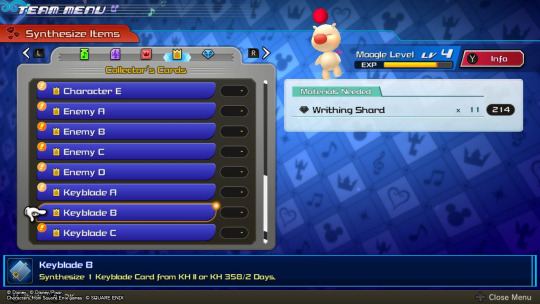
(notice how it says KH2 or Days at the bottom, you don’t even know. Of course I have Writhing Shards rn but that’s because I beat the game and didn’t open a whole lot of keyblade cards but the memory and scene ones are the annoying ones for me)
You don't even have to "finish" the song, just get it most of the way before you die then you'll still get credit and still get a ranking, just no exp. Now, there are also stars, stars are from 'missions' for each stage, if you play KHUX, it’s kind of like how it says “get this amount of Lux” or “use this type of medal” or “don’t use continue” so most stars are just “get this many points” and you need to collect enough stars to get to the next area. With that, so long as you have enough stars, you don’t “have” to play every stage, just like regular Kingdom Hearts and skipping worlds, I did though, just for sport, except Let it Go, just for spite. I could see plenty of fans going after those A+++ Proud Performer 3-Star rankings, I can't wait to see the hype it generates, same with the co-op.
They went all out when they didn't have to. The Museum is where everything is collected, so all the cards you collect and craft. You can also just play the song on its own without gameplay through the Museum, so if you want headphones to just chill, it's really nice. You can also play the cutscenes and memory dives on their own without the gameplay. There are "feats" or missions such as finishing a certain number of songs, like Nook Miles or the ones they had in Re:Mind. You can collect profile pictures for your co-op or versus account, mine is Simba (even though I don’t really use it). But the co-op can get pretty intense as you can “sabotage” each other, which seems similar to a Smash or Mario Kart match, adding that much more to the gameplay.
A few more complaints, one is that certain enemies from a stage, (say, the Wyverns) won't have the same attacks as the other stages, sometimes they'll have it so that you jump to hit them and sometimes they'll just have them take a normal hit without the jump so you can't memorize what each enemy requires (there are too many to really do that anyway). The other thing is more just opinion based, particular enemies such as Large Bodies tend to carry a weight so you need to hit them more than once even if its just one enemy. How it does this is that you hit it and then the enemy gets knocked back as your next note so you hit them again. There were definitely times where I struggled because I knew I was hitting the buttons but nothing was happening, I would guess timing was the problem in some of those cases but the indicators can be difficult to keep track of because it has to be “just right”. I think even just a line on the floor to tell when you’re supposed to hit would be a major help but in a way, I feel like that’s on purpose. Also, in the Museum, you can view all the cards EXCEPT the Keyblades which is pretty shotty if you ask me, what's the point in grinding to get my favorite Rumbling Rose, if I can't even look at it properly?

(also new names for some keyblades (this is a zoom-in))
There will be a lot of things happening at once which can be daunting, I do appreciate that they included the easy, standard, and proud modes though. Keep in mind, each of those are used for individual songs, not playthroughs so if you want to change, go ahead, at least as far as World Tour goes. On top of that, there are different modes that also gauge at how good you are (to use on the track selection). There's the basic mode which I already explained, then there's the one button mode which should be self explanatory, and then there's the performer mode which is quite a lot to put on your plate all at once because on top of normal gameplay, you're adding new buttons and things in the middle of your attacks, I would probably only recommend that after you've got a decent amount of experience because I tried it day 1 and it seems like you would need a good understanding of the game and to be on the same wavelength before even attempting it. You can view a playthrough of each stage called a "demo" which is the little play symbol button next to the "play" button, it shows you how you should be playing to get an A+++ rank and giving you a heads up of what's to come, all excellent all the time. On top of that, when I was playing Xenoblade, one thing I proposed was flicking the analog stick in a certain direction for each move, that’s present here in the form of bosses and memory dives but if you want it to, you can go into the menu to enable it for regular gameplay. You'll find out if you want it on the very first stage, again, I would only recommend it after a lot of experience.
Your characters level up but it mainly just has to do with HP so you don’t die so easily but at the same time, you have potions so I don’t see much of a point for normal gameplay. All three of the party members only have one health bar, so leveling does come in handy for the bosses. However, I don't understand how each party member has a different level, maybe it's just based on the amount of notes you hit with that character but it's kind of weird because I don't think it matters. Even on the team selection part of the play screen, it has one compilitive level so why would they be different on the menu?
For bosses, you only encounter a few. If it were me, I would've made one per game but it is what it is. You don't worry about jumping anymore, it's just holding the attack button down instead and the amount of "dodge" notes that you hit will work in your defense whenever the boss attacks. Once the dodge section is over, it actually tells you how you did with the dodging section. The first time I ever did it, it said "Oh No." it has a sense of humor, it took me a while to nail those ones you hold down which is odd because I rock the gliding sections most of the time.

There's only one more type of gameplay type I can think of, memory dives. It's similar to a boss but you're flying and there's a scene playing in the background, also some of the directional notes will have doubles, so you need to point the analog stick in different directions which is as difficult as can be because you have to use BOTH analog sticks (took me forever just to figure that out). You 'mainly' gain the memory dives from crafting which is a bit odd but you unlock the recipes and items as you go through World Tour and then play them separately in Track Selection, until you get to KH3 at least.
Keep in mind that I played the demo on both PS4 and Switch and compared the two, my performance was about the same, though I will say this. With Switch, you can take it on the go and just do a few levels here and there as well as remove the joy-cons. The thing about that is that I feel the need to shake the joy-cons but there's no function that uses that in the game, I really wish there was though. And those directional ‘slide’ notes have to be way easier on PlayStation because the analog sticks are right next to each other.
1 note
·
View note
Text
Anime Update 43
Dragon Ball - For a while I was thinking this filler episode was a step up from the last one, and then it got worse! The dub already wasn’t doing it much favors with Chris Sabat voicing Master Chin in a pretty dull performance with some confusing line reads; for instance, he tells Rising Dragon that “the only transgression here is you accusing my son of stealing your wallet, Dragon”, but the last part of that line came out as “stealing your wallet dragon”, which left me wondering what the fuck a “wallet dragon” was supposed to be until I realized that “Dragon” was the guy’s name. Jerry Jewell as Sky Dragon was also petty stiff, though I guess it fit for a one-dimensional antagonist. The last third of the episode is where it lost me. Chin’s son was both too sympathetic in how he was being overlooked by his father in favor of Goku and yet then too unsympathetic in how he pretty much attempted to poison Goku in order to steal his place in the fight. The fight itself was a joke, with Goku feeling sick ultimately doing nothing to make his victory harder earned, and the victory itself was so anticlimactic that I couldn’t believe that was really the end of it. And then to make it all the more insultingly stupid, the Dragon brothers suddenly become goodies just because Sky Dragon was beaten by a kid, with him thanking Goku for robbing him of his vengeance and teaching him...something. Ugh. Was not a fan of this one at all.
Love Live Sunshine! - I only watched the third episode of Season 2 this week, which advanced the story a little more and presented an interesting dilemma for Aqours of whether they should be at the new school open house or their Love Live entry concert when both are marked for the same day. And while I mostly enjoyed the episode and especially got a laugh out of Chika’s solution for how to get back to the school on time after performing as a group (both the totally sudden and random “ORANGEEEES!” moment and the super slow orange cart losing its steering and turning into a literal roller coaster ride), I’m not sure we needed to see two Aqours performances in one episode. The second one that took over in place of the usual ED credits in particular seemed like overkill and more suited for a bigger episode or a grand finale than only three episodes into the season.
My-HIME - I finished this series with its two-part finale and while there are some things not to like (which I’ll get to), I was mostly very positive about it and thought it ended the story in a satisfying way. You either like it and see it as a good Don Bluth Ending after all the darkness of the previous episodes or hate it and see it as a huge cop-out, and I definitely lean more towards the former. I think Mashiro having had a plan all along to end District 1 and the HIME cycle along with the destruction of the Obsidian Prince fit with what was set up, and it made total sense to me that it’d come with the restoration of the HIME’s most precious people to them so that they may finally know happiness and peace. The final episode itself was also exhilarating to watch, with Miyu reawakening Alyssa’s shiny golden power being the key to thwarting Nagi and reviving Mashiro, the emotionally charged Mai VS Mikoto battle, and even a much appreciated Tate VS Reito fight where the former redeemed himself for his previous uselessness. The best part, though, was the total unabashed outpouring of love that was the central theme in all this. Tate declaring his love for Mai, then Mai in turn declaring her love for Mikoto, and then Mikoto in turn declaring her love for Reito, and then all the HIME joining together in love rather than being torn apart and at each other’s throats in hatred in order to destroy the HIME star and wipe out the Obsidian Prince for good. The ending sections also did what I wish was done in the finale of She-Ra and the Princesses of Power - allow breathing room for the fallout after the final conflict’s settlement and all the characters getting their happy endings.
For the less good stuff - the Obsidian Prince sucked as a final boss. His character was already very stock Big Bad with a typical “this world is imperfect, I must remake it in my image!” motivations, but when he came out of Reito in his true form, he just talked a bit and stayed their motionless as the HIMEs and their Children came in to very abruptly obliterate him from existence. WEAK. I also wasn’t sure how I felt about that bit of bathos with Mikoto seemingly dying and the scene being very emotional only to whiplash into “Psyche! She was just passing out from hunger!” It felt kind of tasteless. And of course there’s the matter of just how hunky-dory and happy-go-lucky everyone is in the end, even with certain characters who got let off with slaps on the wrist for their transgressions that they’d committed only days earlier. Shiho literally caused Takumi’s temporary death yet Mai’s A-OK with her again. Shizuru suffered no consequences for her random bout of yandere insanity because saying “sorry” for it makes it all better. I loved Alyssa becoming the Girl Boss in charge at the church and having Miyu and Nao working with her, but none of these three girls give any indication they’ve changed in any way. Nagi, who flat out served the Obsidian Prince and literally made so much of this shit happen, gets to walk away contently all buddy-buddy with Mashiro like nothing even happened (admittedly, I do kind of ship it, don’t at me). But the worst by far would be goddamn Wataru, who’s still together with Sister Yukariko who is pregnant with his baby! That’s just horrific. I’m rather disturbed to think we were actually meant to root for these two together, but the writers forgot to provide Wataru with any decent qualities, thus us with any reason for why we should be on board with him and his victim getting together like this!
This series overall is a great example of an anime series that could’ve been a lot better plotted, better structured, better realized in its ideas and just plain better overall, but it does get by with being just...good. It’s an adequately good anime and is the bare minimum of what it needs to be on the whole, and I can’t say I didn’t enjoy it.
Assassination Classroom - The very start of this episode before the opening made me howl from how random it was. Sonny Strait really can do no wrong with this performance, huh? The rest of the episode was another one where it felt like both halves were pretty self contained, but at the same time they both shared the common link of the Kyoto class trip that started up last episode. It turns out that throughout the whole thing there was a sniper hired by Karasuma to try and whack off Korosensei at various stops, and much of the class was in on this little scheme. Unsurprisingly, Korosensei thwarted each snipe attempt in the most unthinkably ludicrous of ways, and Red Eye’s comical reactions were perfect each and every time. When Korosensei finally appears to Red Eye in person, it’s such a classic Korosensei moment - he’s all dark and scary as he says he thought he’d finally “drop by to say hello” in his menacing tone...and then the two of them are sitting down for tea together, discussing how the various attempts on Korosensei’s life came with great educational opportunities for his students. Red Eye even seems to be developing a new lease on life after this encounter, which was real sweet. The second half was pure fluff at the resort, which included one of the best jokes the anime’s done - turning the typical “pervy boys want to spy on the girls bathing to see them naked” cliche on its head by instead having Rio and some of the other girls acting pervy and wanting to spy on Korosensei bathing to see what he looks like without his clothes on! A frantic chase to kill Korosensei, more awesomeness from Karasuma and Bitch-Sensei, and a surprising clue to Korosensei’s secret love life and dark past “back when he had arms and legs” ensued. Just as surprising was that this time there was a scene after the ED credits, with the head of the Ministry of Defense making new plans for E Class.
Nadja of Tomorrow - Two great episodes this week. The first one got me on the edge of my seat very early in when Smash takes Nadja home to his manor with him...and there’s Bandit Keith waiting for them. The weather outside worsens as the tension between the twins worsen, which was an excellent touch, until it’s storming outside and Keith decks Smash in the face! Both brothers are at odds over many things but particularly which of them should be with Nadja, and they’re honestly both pretty awful to her in the process, putting her in a position where she is forced to choose which one she likes most between them. If things couldn’t get any worse for poor Nadja, Smash’s childhood friend and would-be suitor Marianne turns up again and bluntly tells Nadja to choose Keith and stay the fuck away from Smash ‘cause he’s her’s. I was delighted that Julietta of all people came by to help Nadja through her ordeal, relaying what she’s been through with Leonardo and Antonio in the time since we’d last seen her. Both men had truly fallen in love with her, but her decision had to be based on which of them SHE fell in love with. Which, thank God, was Leonardo rather than Antonio. Despite me having pretty clear memories of this part of the show, I’d forgotten if Nadja did make a choice here or not, so I was surprised when she unquestionably chose Smash over Keith, but it felt only natural that this was her choice. She thought she’d loved her “starry-eyed knight” when he saved her and recovered her brooch, and her initial feelings for Smash was only based on that and who she’d mistakenly believed that he was, but in the process of meeting him more and getting to know the real him, she truly fell in love with him and has feelings for him that she just doesn’t have for Keith. This doesn’t sit well with Marianne, however, so she goes and publicly announces an engagement to Smash! So in the next episode, I thought I was going to hate the further love triangle shenanigans, but when it got to the point where Nadja, Smash, and Marianne were traveling to Vienna together, by ship and then by train, I kind of wanted more of it? It’s odd, but the awkwardness that loomed over this trio for the bulk of their interactions was just such fun in its own strange way. Marianne kinda overcomplicates things too late in the story, she’s a bit of a spoiled brat, and her voice acting leaves a ton to be desired, but I find I can’t really bring myself to dislike her ‘cause her personality bounces off of Smash’s and Nadja’s so well and keeps up an energy and sense of interest in what’s going on. Things don’t even seem close to being resolved between these kids as they’re arriving in Vienna, and Rosemary has overheard that Nadja’s coming back to dispute her claims. Think this pisses her off? Nope, she gets a sick thrill out of the idea and puts her game face on! I love her so much!
Mobile Fighter G Gundam - Apparently Andrew is still alive but in traction right now, and he’ll never be able to Gundam fight again. I feel this is kind of a cop-out but whatever, Allenby’s gone missing! And she’s missing because she was taken away by medics on Rain’s watch, which infuriates Domon to the point where he snaps at her, yells in her face, strikes her, and says things that validate all the fears she’s been having of being a liability to him for some time now! GEEZ, DOMON! Get a fucking attitude adjustment already! Of course we know that it was Wong’s men who took Allenby and that Wong has her now, but the search from her is halted due to Domon getting taken on a boat ride out to the ruins of old Hong Kong by his old master’s white horse (yes, really), and once there doing battle with Master Asia himself (or Undefeated Of The East as I guess we’re supposed to call him now), which itself gets derailed by a rogue Gundam Head sent by Wong, so Domon and Master have to call a truce and work together to navigate through underneath the wreckage and get out of this fix. It’s just as fun and awesome as it sounds. At one point, Master has a Lysandre-esque “THEY’RE FILTH!” moment of misanthropy that hints at genocidal intentions, but at the same time you can really see how he, even now, really does see Domon as like a son to him, and even Domon starts coming back around to seeing Master as his second father. It’s such a complex relationship and I never tire of seeing it. And speaking of relationships...no, I’m not talking about the big upset that is Rain breaking things off with Domon and resigning from Neo Japan’s team, I’m talking about Master and Wong. The announcer’s opening for the episode really made it sound like they were now in a lover’s quarrel and that would be the episode’s focus! Now I feel cheated!
But the true highlight of the episode was that because the tone will get more serious from hereon out, the show delivered its crowning apotheosis.of sheer over-the-top, off-the-walls goofy lunacy: Master Gundam’s unicorn mobile suit that it rides is actually piloted by Master’s actual white horse. THE HORSE IS A FUCKING GUNDAM FIGHTER WITH A TRANSFORMATION SEQUENCE AND EVERYTHING, I SERIOUSLY CANNOT EVEN....WHAT!?!?
AND (*drumroll*)
Angel Beats! - Yes, CLANNAD’s old spot, for a while at least, is being filled by a rewatch of Studio Key’s immediate anime follow-up, which I first got into this very month last year. Unlike CLANNAD, I’m putting it last on these posts rather than first because under the cut I will be recalling my first time viewing reactions to the episodes and their events while also offering some additional commentary based on anything new I might’ve picked up on and how things hold up for me on repeat viewing, which could make these get a bit lengthier.
So...let’s go die, everyone!
- The opening song, “My Soul, Your Beats” is a total fucking bop. Seriously one of the most beautifully composed and performed songs I’ve ever heard as an anime opening. The opening animation for it is also spectacular, really emphasizing the splendor of the purgatorial campus and that this is to be a story of Angel, Yurippe, and Otonashi, with some other dead high schoolers thrown in as well, some of them distinctive and memorable, others not as much. It guaranteed me right off the bat that this was sure to be a particularly special wild ride in only 13 episodes...
- We start with Yuzuru Otonashi as our viewpoint protagonist and it will stay that way the whole way through. Our main character who....actually has a character in this episode? Yeah, hard to believe but Otonashi had a pretty damn strong start here. I distinctly recall as I watched this the first time taking quite a liking to him and feeling he was better than I’d thought he was going to be...and can just as distinctly recall the disappointment setting in when in just the next episode he becomes exactly what I thought he was going to be, which is the most bland and generic guy in the world. In this first episode he had more of an edge to him, and a lot of good, well delivered lines (”I want to talk to someone around here who’s not some kind of high school sniper at age 16″, “I can’t believe I almost fell for that, dammit! Why did I listen to her, I don’t even know who I am!”, “I’ll get myself obliterated and then I can kiss this world goodbye!”, “Is there someone I can actually trust around here? Someone with a driver’s license, please? A teacher? Wait a minute...where are all the teachers!?!” “Screw You Battlefront.”, “Leave me outta this, dickwad!”, “I’m so disappointed! You’re just a bunch of bullies with weapons!”, even a “What the F---?”) Not only was he and his situation interesting to follow and his reactions and dialogue so entertaining, but by the end he shows himself to be one of the smarter characters who thinks and acts the way I’d want anyone in his position to think and act. He sees how suspicious Battlefront is, how strange, pointless and fucked up the premise he’s been pulled into is, and though he allows himself to join Battlefront so that he has a place to stay and people to stay with, he mentally hasn’t given himself completely to their cause, just biding his time until he gets all of his forgotten memories back. Good on you, Otonashi, that is just how I’d approach things here. I think the reason for Otonashi coming off as a different character in this first episode compared to the rest of the series might be because Jun Maeda was coming off having written such a great male protagonist in Tomoya Okazaki that he basically wrote Otonashi as Okazaki, thinking he could make that lightning strike twice. I don’t know if it was the design or the voice actor (though both his original and dub VAs do a great job in the role) or the whole amnesia factor or the fact that he was surrounded by characters inherently either more compelling or more entertaining, but apparently it just wasn’t clicking for Maeda, who felt more passion for the likes of Yurippe and Kanade, so he then opted to just write Otonashi as a kind of blank slate Vanilla Protagonist whose grounded, mundane normalcy is good for other less grounded characters to bounce off of and whose story arc across the narrative makes him the living embodiment of the series’ core themes and ultimate spiritual message. We certainly can’t blame the forced episode cut for this since it started in Episode 2, which was scripted and being made before the cut was forced on KEY. Maeda just didn’t take much interest in Otonashi. At least he got some time to shine!
- But enough about Otonashi. The first character we’re introduced to through his POV is the show’s true star - Yuri “Yurippe” Nakamura, leader of the SSS Afterlife Battlefront. Of course, she introduces it as “Not-Yet-Dead Battlefront” because Battlefront not being able to decide on a name for itself was a joke for this episode only. Within seconds of hearing her talk, I was in love with this girl and that feeling was as strong as ever on rewatch. She’s looking into a sniper rifle entirely set on shooting her school’s student council president dead, gives some exposition about being dead and in purgatory and at risk of being “obliterated” by God, goes on a slight ramble about her group’s name dilemma, on the fly tries to recruit Otonashi into joining her, gets in his face and yells about how idiotic he sounds by suggesting he go down and meet Angel, and even takes that opportunity to make a “go die!” joke to him. As Otonashi thinks, this girl IS crazy but it’s the kind of crazy I wanted more of. Later parts of the episode also show how firm in her convictions she is, in addition to being ill-tempered, informative, bold, charismatic, strategic, and a surprisingly inspiring leader to a bunch of teenage dumbasses for being a teenage dumbass herself, and Brittney Karbowski’s voice acting as her in the dub…just pitch perfect. She is mesmerizingly good at nailing down Yuri’s personality and making her so likable.
- Angel seems like a generic White Haired Cute Anime Girl/Rei Ayanami Clone when we first meet her, but her voice, which sounds pretty identical in both versions, carries a sense of awkwardness and adorability to it, and even her stoic facial expressions tend to look cute due to her big eyed Moe look. She says she is not an angel, and I’d be inclined to believe her if a few seconds later she didn’t call forth some completely unnatural power and stab Otonashi in the fucking chest. For me and I think many people, this was officially the “OK, this show is BALLS TO THE WALLS MADNESS” moment, and if it did its job right (which it did for me), it got us eagerly anticipating anything and everything that could follow that unexpected turn.
- Is there a character introduction more gloriously WTF and violent than Noda’s? Noda, AKA Halberd Guy, is immediately one of the best and most memorable characters on the show when he comes in like this, taking offense on behalf of his beloved boss, raising his weapon at Otonashi and asking “wanna die?”, and then showing he was serious about that by slashing and bludgeoning Otonashi to death 100 times over - “DIE DIE DIE DIE DIE DIE DIE DIE DIE DIIIIIE!” - leaving him a bloody mess on the floor. It’s all at one hilarious, a great way of establishing Noda’s identity as a character, and a reaffirmation that dead people in the afterlife can’t truly die via crossing the line twice and brutally murdering a guy who’d just been brutally murdered a while back. A legendary anime moment; I love it.
- Sweet Jesus do I adore the scenery in this show. It combined with the studio’s masterful sense of atmospheric animation and mood setting through both the writing and the soundtrack results in something that’s just irresistible for me to take my eyes off of.
- Otonashi gets sent hurdling out the principal office’s window to his death by a trap bludgeon that swings out when he tries to enter without having spoken the right password first. Minute later, it happens to Noda too, and he’s the one who devised this trap in the first place! The deadly slapstick just doesn’t let up on this show.
- The back-and-forth banter between Battlefront is just too much, starting right off with “that makes it sound like I’m about to die!” when discussing name proposals. Especially great were Yurippe’s reactions to the names she’d reject and how she ends up almost declaring the group as “the Barnacle Battlefront” due to a big discussion that had escalated to the point of that even being a thing that could be said, resulting in Yurippe kicking Fujimaki in the face for having thrown out that name and him even complimenting the kick. It really gives off a sense that these idiots have been comrades in arms for quite a while and this is just the sort of dumb shit they’re used to when it comes to group discussions.
- Yurippe makes a compelling case for fighting for total freedom in a world where death holds no power over anyone, but the idea that deposing or getting rid of a single girl who they believe to be an agent of God will accomplish this is kind of a stretch, and then when she says that if they get rid of Angel, “this school and this world will belong to us”, sirens were going off in my head and I sure hope they were going off in Otonashi’s as well.
- The password is “There is no God, Buddha, or Angel.” Except Yurippe later says she leans more towards believing in God’s existence, Buddha was very much a real historical person, and there is very clearly an Angel that Battlefront is dead set on fighting. I don’t think this password was thought through very well, but then again with this group, it’s always a 50/50 chance that anything will be.
- As with CLANNAD, Jun Maeda more than delivers on the soundtrack. I really liked hearing the instrumental of “My Greatest Treasure” playing during the big name introductions scene - somehow that song doesn’t move me to tears when it’s just background music!
- The English dub couldn’t really translate the whole “SSS” thing very well. It’s meant to stand for “Shinda Sekai Sensen”, which translates to “World of the Dead Warfront”. Basically “Underworld Battlefront”, or “Afterlife Battlefront”. But since no one in the dub can actually use the phrase “Shinda Sekai Sensen”, the meaning behind the SSS gets lost. So Yurippe just says “We’re Class SSS” and that’s the end of it, no dwelling on what the letters even stand for. This was a part I always found to be weird.
- Watching this episode again made me even more appreciative of its pacing. The two acts are evenly divided between an act of “questions” and an act of “answers” - Otonashi is in the dark about everything in Act 1 and it ends with him agreeing to join Battlefront, thus Act 2 provides him with answers to many of his questions and gets him accustomed to what his new status quo will be like without answering absolutely everything so that he’s still left with room for doubts and contemplation in the end. All of it seems to flow naturally without feeling rushed, no minute seems wasted, and all the content needed for this show’s premiere episode is accounted for.
- Exposition scenes are hard to pull off, but most of the exposition in this episode is delivered by Yurippe, and she’s just got such a strong presence and so much raw charisma in her voice that I found and still did find myself totally on board with listening to the details she shared. You can really get the sense that despite this being an original anime first, Maeda had a visual novel tutorial in mind when he wrote these parts. Though I will say that referring to the world’s natural non-living residents as NPCs is kind of silly and makes Yurippe sound like some Alt-Right gamer nerd.
- Yurippe donning her beret hat, turning off the lights as the flashy commander screen turned on, and announcing Operation Tornado (”We’re gonna blow away the student’s meal tickets!”) once again got the sirens going off in my head. What Battlefront calls an act of rebellion against Angel, I and Otonashi call petty theft and bullying.
- Hey look, an Early Bird Cameo for Yui! Probably my favorite character on the show next to Yurippe, I can’t wait ‘til she’s properly introduced! Also, hearing Luci Christian delivering such a cool, confident voice for Iwasawa is kind of surreal after having hearing her as Nagisa for so long...
- THAT. CLIMAX. It got me so pumped, so into the moment as I watched the spectacle unfold before my eyes. This is what really set Angel Beats! apart from this studio’s previous work - an action sequence with superpowers and weapons clashing while a rock concert is going on inside the school building? This is most unorthodox! Angel really went from a cute little white haired girl to an absolutely intimidating and nightmarish foe here, coming at Otonashi and co. without flinching, without relenting, without changing expression, taking everything they could throw at her with ease. This menacing quality doesn’t last with her for long (save for when she uses Harmonics, that is), but in this sequence you can actually see why she could be viewed as an evil enemy by Battlefront. The whole thing is set to “Crow Song”, which Girl’s Dead Monster (or GlDeMo for short) is playing for their concert at that moment to distract the normal NPC students before the big fans go off, and it really makes the whole thing, adding to its intensity and how enjoyable it is.
- By the end of the episode, as Yurippe has ordered the fans turned on so all the meal tickets go flying and get stolen, and Angel just stands there at a distance as a solitary, lonesome figure while Battlefront retreats, any doubt about who the good guy and bad guy in this conflict is vanished from my mind. But because Battlefront refrain from using all their weaponry and resources to do more damage and overtake the school, instead just using their stolen tickets to buy meals and eat them together like anyone would, Otonashi remains in doubt about who to trust but sticks with this group because he’s got nowhere else to go and he needs to bide his time. And the episode closes out on this note. The end credits here just flashes the SSS insignia on the screen as the haunting “Brave Song” plays for the first time. When I first heard that song and read its lyrics on the screen, I was like “...OK, I’m really unnerved now.” and then correctly assumed that it was meant to be Yurippe’s song. For possibly the only time, I related to Otonashi - I felt like I’d landed in the clutches of a maniac and her cult of personality, saw no way out, and was uncertain about what could come next...but at the same time, quite curious and interested to find out.
- I love the next episode previews on this show ‘cause they just have words on a white screen and audio clips of those lines being spoken by the characters who speak them, with the final line being one of particular importance. The line this time was “I don’t know what that is!”, spoken by a much younger Yuri Nakamura. Oooooooh no...
Yeah. It was every bit as fun and brilliantly chaotic as I remembered it being, so I’m all too thrilled to keep up this rewatch from here.
1 note
·
View note
Text
QUEERBAITING: BAITING A QUEER AUDIENCE WITH THE PROMISE OF REPRESENTATION?
So, I finally got around to translating my term paper on Queerbaiting. I initially intended on translating it all manually, but ended up not having the time for it. Finally I decided on using DeepL for the translation, as it works great for academic writing and can handle german sentence structure.
This paper was written in September 2018 and turned in on September 31st. It was graded with 1.3 on the german academic grading scale (”very good” or ~3.7 in the US).
Introduction
Although the phenomenon of queer baiting made its way into media research a few years ago, the number of publications written on it remains manageable. A keyword search provides 125 academic texts containing the term "Queerbaiting" and almost exclusively from the last 5 years.[1]
Nevertheless, queer baiting does not seem to be a topic unknown to the non-academic general public. A search with common search engines and the keyword "Queerbaiting" yields 150,000-175,000 results [2], including Wikipedia entries, videos and articles in online magazines. In the English-speaking world there are various online articles that deal with this phenomenon - often in relation to television series such as Once Upon A Time (cf. Langfelder 2016) or The 100 (cf. Shakeri 2017). But there are also German-language texts on this topic (cf. Sky 2018). Even in the Lexikon der Filmbegriffe of the University of Kiel there is an entry on this subject (cf. Schlichter 2017). Queerbaiting seems to be a topic that repeatedly sparks discourse.
In social media, users can exchange views on this topic and there are different opinions on what can be considered queer baiting and what not. In preparation for this work, I have asked online for examples of queer baiting in order to extend the selection of the object of investigation by the examples I know personally.[3] The following answers show a dissatisfaction with the current amount of representation of queer [4] relationships in film and television. Among the mentioned examples were the already mentioned television series The 100, the series Supergirl, Riverdale, Pretty Little Liars and 13 Reasons Why, as well as the cross-media Harry Potter franchise.
But queer baiting is not limited to the protracted storylines of television series; this phenomenon can also be observed in games like Life Is Strange or films like the Pitch Perfect trilogy.
The present work deals with the term queer baiting and the related concepts. In this context, the representation of LGBTQ+ identities in American Hollywood film will also be discussed. In addition, two social media posts will be examined as concrete examples, which served as advertising for the film Pitch Perfect 3. The work will answer the question why queer baiting can be so frustrating for LGBTQ+ viewers and which mechanisms make queer baiting possible.
[1] Via Google Scholar, as of 24.09.2018.
[2] Via Google: 153,000 results, via Yahoo: 175,000 results, via Bing: 175,000 results, as of 24.09.2018.
[3] This took place via a post in the anonymous social network Jodel, in a channel (@girlsgirlsgirls) in which primarily LGBTQ+ topics concerning women are discussed. The respective post can be found under the link:
https://share.jodel.com/post?postId=5b210941c3c100000f3bced8&channel=other&_branch_match_id=572700582120145397.
[4] Queer as generic term for identities and sexualities falling into the LGBTQ+ spectrum.
Terminology
Queerbaiting is a term coined by fans, whose meaning has changed over the years (cf. Nordin 2015: 4f.). Also in its established meaning there are different approaches of how the term can be interpreted.
Eve Ng defines queer baiting as a practice originating from producers that exploits the interest of recipients in narratives with LGBTQ+ themes without actually fulfilling these expectations.
I use the term queerbaiting to refer to situations where those officially associated with a media text court viewers interested in LGBT narratives - or become aware of such viewers - and encourage their interest in the media text without the text ever definitively confirming the nonheterosexuality of the relevant characters. (Ng 2017: 1.2)
By this, however, she also understands narratives that contain LGBTQ+ themes, but where there is a discrepancy between the audience's expectations and actual representation in the media text. It is precisely this discrepancy between the expectations built up and the actual text that constitutes queer baiting for her (cf. Ng 2017: 1.2). These expectations of the audience arise through both intratextual references and the "producer paratext", which contains information on the text from the producers (this can be any form of extratextual promotion from the producers) as well as through so-called "queer contextuality" - the summation of the audience's previous experiences with the media representation of queer figures (cf. ibid.: 1.3, 2.5).
While Ng uses her definition very openly, Judith Fathallah is much more precise:
Queerbaiting may be defined as a strategy by which writers and networks attempt to gain the attention of queer viewers via hints, jokes, gestures, and symbolism suggesting a queer relationship between two characters, and then emphatically denying and laughing off the possibility. (Fathallah 2014: 491)
In this definition, the focus is less on the relationship between producer and recipient, instead it defines queer baiting via intratextual cues and codes, and the intratextual rejection and/or mockery of a queer relationship.
The core of the phenomenon remains the same in both definitions: First, references to a non-heterosexual relationship are scattered, be it in the text or in the paratext - a queer reading is promoted - this leads to expectations on the part of the recipients, these expectations are then not fulfilled in the text, the relationship is not realized or possibly even the possibility of a queer relationship is dismissed as absurd. Queerbaiting is therefore a concept to be understood literally: one is baited with a queer relationship.
While queer baiting is a rather recent phenomenon (cf. Nordin 2015: 66), queer readings of media texts go back further. The queer interpretation of the relationship between the characters Spock and Captain Kirk of the Star Trek franchise demonstrably dates to the 1980s and beyond (cf. Jenkins 2006: 90f.). This interpretation of media texts - "queer reading" - stems from the lack of adequate representation:
A queer reading is constructed by a reader who, denied the obvious manifestation of homosexual desire, in a context in which heterosexual desire is normalized, seeks to identify the codes by which authors have indicated passionate relationships between same-sex members of their texts or have created available metaphors through cross-species relationships. (Mendelsohn 2002: 45)
Queer baiting is thus always connected to queer reading, since it would not be possible without this reading by the viewer - only the willingness to regard certain codes as homoerotic subtexts enables the systematic exploitation of these by producers.
The definition of queer baiting used in this work as a deliberate economically motivated tactic is based on the definition of the authors Guerrero-Pico, Establés and Ventura:
[...] 'queerbaiting' [is] a tactic whereby media producers suggest a homoerotic subtext between characters as a means to improve or maintain a show's ratings without actualizing or consummating such a relationship beyond suggestion and innuendo. (Guerrero-Pico/Establés/Ventura 2018: 313)
Although this definition explicitly refers to television productions, it can, in my opinion, also be applied to the example used in this work, which is the last iteration of a film trilogy that takes up subtext established in earlier films.
If one speaks of Queerbaiting, it cannot be avoided to also deal with Bury-Your-Gays, a phenomenon, which often appears in connection with Queerbaiting and represents a similar problem. Bury-Your-Gays is the recurring motif that queer figures in media texts often come to a violent end. In this way, despite the existence of these figures, a heteronormative narrative is promoted by denying queer figures a "happy end" and thus placing queer identities in a negative context (cf. Waggoner 2017: 3). Examples are Chloe in Life Is Strange[5] and Lexa in The 100 [6] . Since queer female characters, mostly lesbian women, often find a violent end in the media, one also speaks in this context of the "Dead Lesbian Syndrome" (cf. Guerrero-Pico/Establés/Ventura 2018: 312). Ng regards this phenomenon (without explicitly naming it) as a form of queer baiting instead of an independent phenomenon (cf. Ng 2017: 1.2).
Guerrero-Pico, Establés and Ventura examine the reactions of fans to the death of the serial character Lexa more closely. Among other things, they were able to observe an online movement called "LGBT Fans Deserve Better", which was primarily concerned with the representation of lesbian and bisexual women on television. This included online attacks on the producers of the series The 100, mainly via Twitter, as well as the wider context of negative fan practices, which for the authors fall under the term "fan-tagonism" [7] (cf. Guerrero-Pico/Establés/Ventura 2018: 312).
[5] If the player has chosen one of the two ends. Also Chloe's ex-girlfriend Rachel, who is already dead at the beginning of the game.
[6] Further examples are Sara Lance in Arrow, Tara Maclay in Buffy the Vampire Slayer, Hugh Culber in Star Trek: Discovery and all queer characters ever released in The Vampire Diaries. A list can be found on the website Does the dog die? (https://www.doesthedogdie.com/#topicTable ).
[7] A Portmanteau from "fan" and "antagonism".
Representation
One aspect of the debate on queer baiting is the question of the representation of queer persons and relationships in film and television. Why is this representation important? And if representation is important, is queer baiting a problem for them?
The prevailing opinion in literature is that representation is important because it serves identity formation and affirmation. Through (positive) representation, negative feelings concerning one's own identity can be overcome and social isolation can be reduced (cf. Guerrero-Pico/Establés/Ventura 2018: 314). What is regarded as satisfactory representation changes over time, what was still regarded as positive representation in the 1990s would no longer be accepted as produced by many people today (cf. Nordin 2015: 63).
Whether queer baiting causes a representative damage is difficult to answer, Brennan sees no damage caused by queer baiting, instead he sees the creative potential for fans who create transformative works (cf. Brennan 2018: 202). However, the indignation caused by queer baiting cannot be denied, so it should be reconsidered whether subjectively perceived damage is not caused by the absence of representation. Guerrero-Pico, Establés and Ventura summarise the views of participants in the "LGBT Fans Deserve Better" movement as follows:
Queerbaiting is perceived, therefore, as a commercial trivialization of the problems that affect lesbian and bisexual fans, who do not find a normalized and healthy representation of their affective and sexual identities in hegemonic discourses (Guerrero-Pico/Establés/Ventura 2018: 327).
While the evaluation of representation in the viewer is subjective, there are tools to create a comparable basis for discussion. One of these tools is the so-called Vito Russo Test. This test, developed by the Gay & Lesbian Alliance Against Defamation (GLAAD) and named after its founder, is based on the Bechdel Test. For a film to pass the Vito Russo test, three conditions must be true:
The film must contain at least one character that is recognizably gay, lesbian, bisexual, transgender and/or queer.
This character must not be primarily defined by sexuality and/or gender identity.
The character must be involved in the plot of the film to the extent that his or her absence would have a significant effect on it - he or she must be of significance. (cf. glaad.org 2018a)
The organisation GLAAD also publishes an annual report entitled "Studio Responsibility Index" which examines and classifies the LGBTQ+ representation in the films of the previous year of the seven largest Hollywood film studios[8].
For the 2017 film year, 12.8% of the films examined contained at least one LGBTQ+ character, of which 64% were gay men. Overall, 71% of the LGBTQ+ characters were men and 29% women (cf. Glaad.org 2018b). Of these films, 64% passed the Vito Russo test (cf. Glaad.org 2018a).
The film Pitch Perfect 3 and the studio Universal Pictures (short: Universal) dealt with in the following section can also be found in this report. Of the 14 films published by Universal, 4 included LGBTQ+ persons, so that Universal published the most LGBTQ+ inclusive films of the studios surveyed, of which only one passed the Vito Russo Test - Get Out. Pitch Perfect 3 did not pass the test, despite the presence of a lesbian character[9] (cf. Glaad.org 2018c).
[8] 20th Century Fox, Lionsgate Entertainment, Paramount Pictures, Sony Pictures, Universal Pictures, Walt Disney Studios and Warner Brothers.
[9] The character Cynthia (Ester Dean) is only a background character.
"Ship": short for "relationship".
Pitch Perfect 3
The Pitch Perfect Trilogy is about a fictional university's A-Capella group The Barden Bellas, which protagonist Beca (Anna Kendrick) joins in the first film of the trilogy. The sequels play about 3 years after their predecessors and show The Barden Bellas during and after their time at the university.
The example I chose coincidentally shares a name with the video game Life is Strange: Chloe (Brittany Snow). This was connected by fans with the name Beca to the Portmanteau "Bechloe". This "ship name"[10] is used by fans to refer to the romantically interpreted relationship between the two characters. This relationship, however, takes place exclusively in the subtext and parate text of the films. The latter will be examined further here.
Already in 2016 Kendrick spoke in an interview with the LGBTQ+ magazine The Advocate about the relationship between the two characters and called it a quasi lesbian relationship[11] (see Advocate.com 2016). In the same interview she indicated that the homoerotic subtext perceptible in the second film was intended by the production side as a reaction to the queer interpretation of the relationship through fans (ibid.)[12].
Online marketing for Pitch Perfect 3 also plays with this interpretation of the relationship between the two characters. A commercial clip distributed in the Snapchat app shows Kendrick and Snow approaching each other, giving the impression they're going to kiss next. Instead, they turn to the camera and Kendrick asks the viewer to move up for more (in the app, linked websites or additional information can be accessed via this function). Due to the way the app works, previous content can no longer be accessed, but the video was saved by a user and published via Twitter[13] (Figure 1).
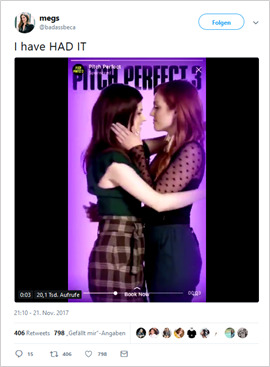
(Figure 1)
From the user's brief commentary it can be concluded that she felt a certain resentment about this type of marketing. In the reactions of other users to this post, the term "queer baiting" already appears repeatedly, so it can be assumed that at least some of the users regard this video, or the film to which it refers, as such.
The video plays with the expectation of viewers who emerge from a coded body language. Due to the physical closeness and the placement of the two actresses' hands, a pictorial language emerges with which otherwise romantic relationships are represented. The invitation to the viewer insinuates that a kiss is possible and that perhaps there is room in the film being advertised. The viewer who is interested in queer narratives thus gets an incentive to see the film, which, however, does not fulfil this expectation.
Another video[14] published on the Twitter account "Universal PicturesUK" shows scenes from the film Pitch Perfect 3, including a scene in which the seemingly naked characters Beca and Chloe stand behind one another, a scene in which the two characters are again shown over which red hearts have been overlaid digitally this time, and a scene in which Chloe puts her hands on Beca's chest to push her aside and then grabs her further, observed by the character Aubrey (Anna Camp).
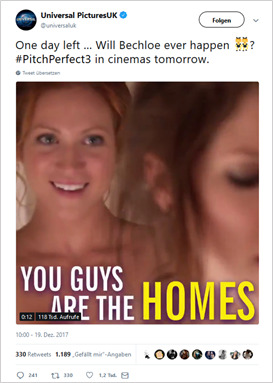
(Figure 2)
The video is accompanied by the comment: "One day left ... Will Bechloe ever happen 👯? #PitchPerfect3 in cinemas tomorrow." (Figure 2). Not only is a very clear visual language used here, the term "Bechloe" is also used in a targeted manner, thus revealing an awareness of the possible queer dimension of the relationship. The queer reading is taken up and reinforced by the montage of the film scenes. In the context of the film, however, these are treated more as jokes than as opening up an actual romantic dimension, for which the film was criticized by GLAAD, among others (cf. Glaad.org 2018c).
On the basis of these examples, three observations can be made which answer the question of whether this is queer baiting:
The producers were aware of the queer reading of the material.
The producers used this reading to build up the expectations and hopes of the audience and to give them an incentive to see the film in the cinema - aware that these expectations would not be fulfilled.
The exploitation of this queer reading had no negative effect on the economic performance of the film, Pitch Perfect 3 was more successful than the first part of the trilogy, although not as successful as the second part (cf. Boxofficemojo.com).
These observations confirm that the two videos are queer baiting as defined by Guerrero-Pico, Establés and Ventura. In addition to some reactions to social media platforms and some texts published online, a media outcry seems to have failed to materialize; no "Shitstorm"[15] could be observed in this example, as in the Bury Your Gays trope.
[10] "Ship”: short for relationship.
[11] „I mean, our characters are pretty much in a lesbian relationship. As far as we’re concerned, they’re secretly in love.” (Advocate.com 2016).
[12] „If people didn’t think it was cute, we wouldn’t have pushed that chemistry even further in Pitch Perfect 2.” (ibid.).
[13] The video can be found under the title: "Twitter - megs" in the appendix.
[14] In the appendix under "Twitter - Universal PicturesUK".
[15] Shitstorm: „Unter Shitstorms werden in der Forschung krisenhafte Ereignisse verstanden, die ihren Ausgangspunkt in sozialen Medien haben und im Wesentlichen durch Empörung statt sachlicher Kritik gekennzeichnet sind.“ (Pleil & Bastian 2017: 141). "In research, shitstorms are understood as crisis events that have their starting point in social media and are essentially characterized by indignation instead of objective criticism".
Conclusion
In summary it can be said that queer baiting is an economically motivated tactic, the intention is not to represent queer figures and relationships, but to win as many paying recipients as possible. However, it is precisely this representation that is important in the process of identity formation, especially among young people (cf. Guerrero-Pico/Establés/Ventura 2018: 314).
Queerbaiting works because there is already a lack of and - in parts of the audience - a desire for satisfactory queer representation, which leads to queer readings of media texts. In this subaudience there is also the will to consume and spend money for media products in which LGBTQ+ representation exists. Since in most cases this 'need' is not satisfied, or the representation is not long-lasting (Bury your gays), the discrepancy between expectation and actual media text described by Ng (see above) arises - resulting in frustration and disappointment.
The examples chosen for this work show that the homoerotic subtext and the queer reading of the media text is indeed desired by producers and consciously used. Irrespective of how queer baiting is ethically judged, it can also be argued that in most cases it is a targeted false advertising, since it implicitly advertises content that is not reflected in the media text.
Since most of the recently produced films do not even meet the minimum of queer representation described in the Vito Russo Test, the use of queer baiting is unlikely to change much in the foreseeable future.
Sources
Advocate.com (2016). The A-List Interview: Anna Kendrick. Website. Advocate.com. https://www.advocate.com/current-issue/2016/11/01/list-interview-anna-kendrick (27.09.2018).
Boxofficemojo.com. Pitch Perfect Trilogy Movies at the Box Office - Box Office Mojo. Website. Boxofficemojo.com. https://www.boxofficemojo.com/franchises/chart/?id=pitchperfectseries.htm (27.09.2018).
Brennan, Joseph (2018). “Queerbaiting: The ‘playful’ possibilities of homoeroticism”. International Journal of Cultural Studies. 21.2. p. 189-206.
Fathallah, Judith (2015). „Moriarty’s Ghost: Or the Queer Disruption of BBC’ Sherlock”. Television & New Media. 16.5. p. 490-500.
Glaad.org (2018a). The Vito Russo Test (2018). Website. GLAAD. https://www.glaad.org/sri/2018/vitorusso (26.09.2018).
Glaad.org (2018b). Overview of Findings (2018). Website. GLAAD. https://www.glaad.org/sri/2018/overview (26.09.2018).
Glaad.org (2018c). Universal Pictures & Focus Features. Website. GLAAD. https://www.glaad.org/sri/2018/universal-pictures (26.09.2018).
Guerrero-Pico, Mar / María-José Establés / Rafael Ventura (2018). “Killing off Lexa: ‘Dead Lesbian Syndrome’ and intra-fandom management of toxic fan practices in an online queer community”. Participations: Journal of Audience & Reception Studies. 15.1. p. 311-333.
Jenkins, Henry (2006). “’Out of the Closet and into the Universe’: Queers and Star Trek”. Fans, Bloggers, and Gamers: Exploring Participatory Culture. New York: NYU Press. p. 89-112.
Langfelder, Natasia (2016). “Let's End Queerbaiting in 2016”. Website. AfterEllen. https://www.afterellen.com/tv/471593-lets-end-queerbaiting-2016 (24.09.208).
Megs (2017). „I have HAD IT“. Tweet (@badassbeca). 21.11.2017. 21:10. https://twitter.com/badassbeca/status/933200998574804992 (26.09.2018).
Mendelsohn, Farah (2002). „Surpassing the Love of Vampires: Or Why/How a Queer Reading of the Buffy/Willow Relationship Is Denied”. Fighting the Forces. Wilcox, Rhonda V./David Lavery. Oxford: Rowman &Littlefield Publishers. p. 45-60.
Ng, Eve (2017). “Between Text, Paratext, and Context: Queerbaiting and the Contemporary Media Landscape”. Transformative Works and Cultures. Vol. 24. Online. https://doi.org/10.3983/twc.2017.0917 (24.09.2018).
Nordin, Emma (2015). From Queer Reading to Queerbaiting: the battle over polysemic text and the power of hermeneutics. Master Thesis. University Stockholm. Online: http://www.diva-portal.org/smash/record.jsf?pid=diva2%3A839802&dswid=2391 (25.09.2018).
Pleil, Thomas / Matthias Bastian (2017). „Soziale Medien in der externen Organisationskommunikation“. Handbuch Soziale Medien. Schmidt, Jan-Hinrik / Monika Taddicken (Hrsg.). Wiesbaden: Springer VS. p. 129-149.
Schlichter, Ansgar (2017). „queerbaiting - Lexikon der Filmbegriffe.“ Website. Filmlexikon.uni-kiel.de. http://filmlexikon.uni-kiel.de/index.php?action=lexikon&tag=det&id=9334 (24.09.2018).
Shakeri, Sima (2017). “Bury Your Gays,' Queerbaiting, And TV's LGBTQ Problem”. Website. HuffPost Canada. https://www.huffingtonpost.ca/2017/06/30/queerbaiting-bury-your-gays-tv_a_23005000/ (24.09.2018).
Sky (2018). „Queerbaiting – Der trügerische Schein einer Repräsentation | Geekgeflüster“. Website. Geekgeflüster. https://geekgefluester.de/queerbaiting-der-truegerische-schein-einer-repraesentation (24.09.2018)
Universal PicturesUK (2017). „One day left … Will Bechloe ever happen 👯? #PitchPerfect3 in cinemas tomorrow.“. Tweet (@universaluk). 19.12.2017. 10:00. https://twitter.com/universaluk/status/943179139590139905 (26.09.2018).
Waggoner, Erin B. (2017). “Bury Your Gays and Social Media Fan Response: Television, LGBTQ Representation, and Communitarian Ethics”. Journal of Homosexuality. Online. (02.11.2017) https://doi.org/10.1080/00918369.2017.1391015 (29.09.2018)
#media studies#tv and film#queerbaiting#university#college#term paper#academic papers#academic writing#academia#writing#mine#studyblr#studying#lgbtq#lgbt#queer
1 note
·
View note
Text
Fist of the Blue Sky: Regenesis, Am I Right?

This review contains a lot of spoilers -- I do not know how much of the anime is congruent with the manga, and as such there may be manga spoilers in this review as well.
Click here to read on Wordpress!

On one hand, as we all ought to know very well,
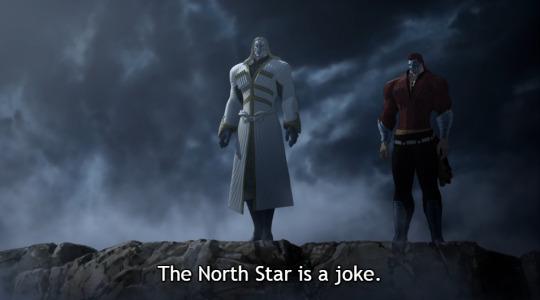
But on the other hand, I think I liked season 2 of Fist of the North Star: Regenesis more than the first, somehow. I also hate to admit there were parts of season 2 I liked completely unironically, as ridiculous and contrived as most of it was. Such is often my experience with every Fist of the North Star anime, game, etc, that I watch -- though I expected it much less from this, on account of it being maligned by pretty much everyone I know who knows anything about Fist of the North Star, for
Being made entirely in CGI (though I still think it’s the designs that are awful, and not necessarily the fact that it’s CGI, but to each their own I suppose when it comes to visuals)
Apparently not following canon much at all, but that doesn’t matter to me because I don’t know anything about Fist of the Blue Sky canon anyway, which makes my viewing experience… interesting… because I just had to accept whatever nutso bonkers lunacy I saw on the screen as truth.
I berated the first season quite a lot, not just for issues in adaptation, but for issues that are almost certainly in the source material as well. I thought the setting was a ridiculously contrary backdrop for the kind of martial arts antics happening on screen, in a literary and in a visual sense. The martial arts themselves, while always ludicrous in the franchise as a whole, were especially so in Fist of the Blue Sky - and in Regenesis their visual presentation was frankly awful, managing to be both tacky beyond imagining and super underwhelming. The writing had serious problems that required -- I'm not kidding and wish I was -- a Magical Jewel That Showed The Antagonist The Truth to resolve the finale, and the backstory we saw through this Plot Orb was complete and utter nonsense, the likes of which I haven't quite seen in a very long time. This really doesn't even cover all of the issues in the first season of Fist of the Blue Sky: Regenesis alone, because the majority of the characters aren't great either, including the protagonist whose value largely seems reliant on being an allusion to the already beloved Kenshiro, and the abundance of small contrivances throughout to fuel completely unnecessary conflicts.
As objectively bad as Regenesis was though, there were some things I enjoyed about it, namely a few of the characters. I loved Fei Yan and Erika, and as much as I hated Yasaka at first, he grew on me – though that was born from the absurdity of his redemption that made it impossible for me to take any of his crimes seriously. On that line of thought though, what I often enjoyed about season 1 was the spectacle of it, and I think that’s pretty clearly evidenced by my liveblog where I was either losing my mind and frantically posting screencaps to try and even begin to understand what I was looking at and how it was possible, or posting about Fei Yan Being Great. And sometimes complaining when I had the energy to think about the awful writing, instead of laugh it off…
So that was season 1. But what did season 2 have to offer, and could it redeem the anime, even a little bit? Well, short answers: A bit more, and not particularly. So let's get to the list making:

Things I decidedly didn’t like at all about Season 2
Need I even say anything about how the CG model proportions are still awful... looking Yu Ling's model makes me ache all over. But not only are the models in general still grotesque, but there were a few too many instances of flashbacks where characters were supposed to be teens, but they either had a kid model, or an adult model. There's no inbetween. It's extremely weird and jarring when in one flashback Simeon looks like a 12 year old with similarly young looking Himuka, and then "a few years later" Simeon still has the 12 year old boy model, while Himuka has evolved into a 30 year old buff martial artist.
Fei Yan is Still Dead and Yasaka is good but he's not that good. This is admittedly a petty complaint but try to understand... Fei Yan was really good. And I miss him. Thank you for listening.
Fei He was wildly under-utilized, under-developed, and usually just a woman for male characters to make fun of or infantalize -- which is a crying shame (and unfortunately par the course for the franchise, ahem) because she was a link back to Fei Yan and his legacy. Having been partially brought up by him and idolizing him in her youth, she arrives near the end of season 1 to track down Kasumi, who she is pointlessly misled into believing killed Fei Yan for a few episodes. Later in season 2 when she does discover it was Yasaka who killed Fei Yan, nothing… happens, because by that time she has already come to respect Kasumi, so it’s trivially easy for Kasumi to convince her to forgive Yasaka just like he did. Once her initial motivation is snuffed out, she just becomes a detached ally of our secondary protagonist group, which consists of Yu Ling, minor members of the Green Gang, and the worst characters of the entire show!
The comedy duo. Far and away the worst aspect of both seasons of the whole show. The CG? The ugly art style in general? The casual misogyny? The non-canon mismatched cult planning world domination with nuclear weapons? That all pales in comparison to the damage these freaks wreck on every episode they are in.
Their horrendous “bits” are where like 80% of the misogyny this show displays actually occurs. Their boorish fantasies are used as vehicles for the only fanservice scenes in the entire run, and they make up ridiculous plans for Fei He to carry out that degrade her and make her a joke.Their bits are tone-shatteringly out of place and usually shoehorned into every episode since their introduction in the middle of season 1 at the worst time possible. I’m still seething about their prolonged scene in the finale where Yu Ling inexplicably rubs the metal-haired one’s head while her fiancee fights for his doomed life, and he pretty much c*ms and his metal wig falls off to reveal a single disgusting hair on his head -- we literally cut away from the final fight in the whole series so we can see THAT. LIKE WHAT? AAAAAAAAAAAAAAAAAAAAAAHHHHHHHHHHHHHHHH!!!!
This show is already so far-fetched and often unintentionally hilarious that it doesn’t benefit in any way from having gag characters in the first place. It’s a net loss in entertainment value, really, because all the gag characters did was ruin serious scenes and interrupt outrageous scenes that were actually funny.
Fei Yan died, Yasaka died, Kasumi died, but THESE CHUCKLEFUCKS LIVED? #JUSTICEFORFEIYAN #GOTHRIGHTS
The whole thing with the vampire cyborg mad scientist soldier making pseudo-zombies. That was a lot even for Fist of the Blue Sky: Regenesis.
Oh, and another quick note about Fei He being poorly utilized: I also didn't like at all how she is revealed to have fallen in love with Kasumi in the finale... like c'mon. Was that necessary? They barely ever spoke! A woman can care about a man dying without being A Thing, Fist of the North Star...

Things I unexpectedly didn’t hate and even sort of liked to varying degrees about Season 2
Speaking of Kasumi, he was a lot more likable in this season and I don't know if it's because we naturally got to know him better as we spent more time with him, or if it's because he just Did More Good Stuff than before, but I'm leaning towards the latter. I really liked his tender moments with Erika going up to the finale and his fight with Himuka was leagues above any of his fights previously in terms of giving us some actual meaningful insight into his personality and beliefs. It's a shame these moments happened in the last two episodes of the series... But I am willing to concede that they were fairly successful in making me like him just in time for him to honourably wander off into the desert and die. Thanks.
As much as I heckled the literally religious cult composed of men in black, mysterious worshippers with pointed hoods sitting around a table plotting world domination, mad scientist soldiers, and assorted martial artists, I ended up kind of liking where the story went with it and the themes that were developed in the last stretch. The second arc had a very on the nose stance on war and weapons of mass destruction as the worst of humanity's creations, and we see it in a lot of places in the story. The narrative unfolding at a time when World War II was on the horizon, the nuclear bomb schematics that had been causing all of the strife in the story being erased from Erika's (a little Jewish girl, as well) mind in the end, and how Himuka was driven to villainy by war and became convinced the only way to create a future without it, was to hit the Hard Reset Button on the earth's population. For all its shortcomings with dealing with the -isms, Fist of the North Star has at least always had anti-war themes, but I especially liked how they were more focused and rooted in history in this season of Regenesis.
I actually... liked?! The villains?!
Simeon had a motivation that was irrational and pathetic, but made sense because of his background. Instead of the story trying to redeem or sympathize with him, he is simply pitied by Himuka who usurps him and puts him out of his misery, which is very rare for Fist of the North Star as a whole. It shouldn't be as rare as it is.
While I liked the anti-war themes, Himuka's motivation felt a lot less organic than Simeon's in my opinion and required a whole episode to be dedicated to explaining it to us, which I'm not a huge fan of unless it's really compelling -- and I don't think it was. Nevertheless I did enjoy his final fight with Kasumi and the philosophy of it, which made it harder than usual not to bend to the narrative's will and mourn him.
They weren’t glorified misogynists or cartoonishly evil goons! 👍
Himuka betraying Simeon and becoming The Real Big Bad was also rather fresh for Fist of the North Star, and it's a shame that it was spoiled in the opening, because if it wasn't I think I might have been surprised. Regardless, shifting gears like that was a good move in my opinion -- even though, yeah, The Villain Is Your Brother, Again.
When Kasumi wins his final battle against Himuka, and Himuka says "I have always been a vessel of nothingness. There is nothing to spill from inside of me" and he like, turns to stone in the rising sun, instead of dying from his wounds? Did it make any sense? No. Was it was raw as fuck and did I love it? Yes.
Erika... her arc in season 2 is very bittersweet, but it is undeniable that I was relieved when Kasumi erased her memories. It's probably not kosher, but when I was watching it I agreed with the narrative's claim that her only way to be free of her immense suffering and live like a little girl should was to clean the slate, and months later when I think back to it, I'm still okay with it. A little girl watching her parents die and being burdened with knowledge that can destroy the world, and everything that happens to her and her guardians because of wicked men trying to get that knowledge from her... I can't really fault the idea of taking that away from her and letting her finally rest. Go play in a sandbox dearest Erika... run along...
Every episode felt like 5 minutes long!
So that's the final impressions of Fist of the Blue Sky: Regenesis -- I ended up having more to say about it than I thought I would, considering how I was speechless most of the time I was watching it... with a list of Positive Points that long, you might be tricked into thinking it's unexpectedly good; but despite everything I liked about it, I can say with confidence that Fist of the Blue Sky: Regenesis is not good. All of the issues from the first season do carry over into this one -- the contrived story-telling and egregious tonal dissonance, lackluster characterization and poor handling of character drama, and just plain absurdity of most things happening on the screen remain intact. Had it not been for a small hand full of likable characters and some good themes trying to pierce through the hideous hide of this story, it would be thoroughly unremarkable, perhaps not even worth touting as a hilarious spectacle of out of context screenshots.
I can't be too sour though, because then I would be dishonest. It's clear as day that while understanding why it is so maligned, I enjoyed many parts of it far more than expected, and the experience of watching it with my partner was fun and at times even emotional. And as much as I can say with confidence that Fist of the Blue Sky: Regensis isn't a good anime, I can also say with confidence, that Fist of the Blue Sky: Regenesis was not even remotely the Worst Anime Of 2018. I think it's very telling that in the anime community, being completely mediocre with bad aesthetics and bad story adaptation are worse sins than that of, say, The Master of Ragnarok & Blesser of Einherjar and Death March to the Parallel World Rhapsody which are both "escapism" series that aired in 2018 and were rampant with pedophilia and slave fetishization that were popular on Crunchyroll when they were airing. Front Page Popular.
Needless to say, watching lots of airing anime every season gives me a sense of perspective and I use it, and so I am content with admitting that I happily watched Fist of the Blue Sky: Regenesis every Monday that it aired and often had a great time, oftentimes because it was an absolute riot to see, and sometimes because despite everything, it could be... decent!

[Happy very belated New Years everyone! I finally finished writing something, so hopefully this bodes well for my productivity in 2019! Enjoy and thanks for sticking with the blog!]
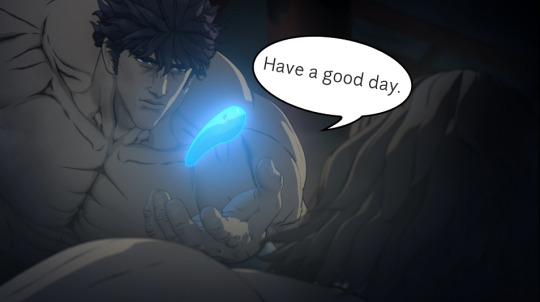
#fotns#fotbs#fist of the north star#fist of the blue sky#Someone Had To Watch It And That Someone Was Me.
2 notes
·
View notes
Text
FEATURE: Crunchyroll Editorial Staff's Top Anime of 2020
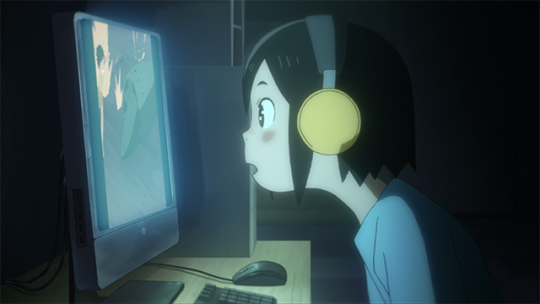
As we near the end of this ... very interesting year, we here on the Crunchyroll Editorial team are taking some time to reflect on all of the excellent anime that has aired this year. While there were plenty of reasons this year to be sad, stressed out, or worse, anime was there to help us through. Our editorial team has members all across the globe, and we came together to celebrate the anime that kept that fire of hope burning inside us all through 2020.

This year, due to many different circumstances, I wasn't able to keep up with nearly as much anime as I would have liked to, but there are a few shows I managed to watch that really left an impact on me this year. The year started off with an explosion of color and imagination with Keep Your Hands off Eizouken! Anime is something so special to all of us and this series about three girls coming together and learning to animate captures the power this medium has to inspire us. Later in the year, we got the first half of Re:Zero Season 2. While it had some ups and downs, the episode that brought us Subaru's fleeting reunion with his parents was a high watermark for the year. Finally, My Teen Romantic Comedy Snafu Climax capped off one of my favorite series of the last decade with one of the most successful, emotionally resonant ends I've seen in a while. I'm so grateful to all of the creators who brought these stories to life for us in a year where we desperately needed them.
- Cayla Coats, Editor-in-Chief for English regions

There are too many cliched phrases to apply to 2020, but despite every hurdle this awful year had, the endurance of those who create our favorite shows was still present. Even in the best of circumstances, these productions are strenuous, but it’s thanks to the work of every animator and staff member who is part of the process that let us enjoy every show this year. For that, I cannot thank them enough. With that, here are the best anime I saw this year.
Keep Your Hands Off Eizouken! - While Eizouken is “an anime about making anime,” it’s far more about animation as an art form and the physical/emotional energy it takes to make ideas into something tangible. An intimate look into what drives artists and one of the truest presentations of “it takes a village,” Eizouken is a love letter to much more than anime as a medium, and a series that aims to share that inspirational magic between viewer and creator.
Beastars - What Studio Orange continues to accomplish with 3D animation is nothing short of incredible, and an ever-increasing shining example of what is possible in the space. Along with the stellar visuals, Beastars’ intricate worldbuilding and story of opposite ends trying to understand each other was one of the most gripping and emotional dramas I watched this year.
March Comes in Like a Lion - This year I found myself, perhaps like many others, finally checking out shows on my “to-watch” list. I can’t tell you why I chose March Comes in Like a Lion from that list exactly, but I can tell you that the 44 episodes of the shogi drama contain some of the best television I have ever watched. What starts as a series about navigating trauma and pain turns into a powerful journey of recovery and self-introspection of finding one’s path to happiness.
- Kyle Cardine, Editor for English regions

This year has been a complicated one, but it also delivered some great moments with anime. January started strong with Keep Your Hands Off Eizouken!, a series in which its protagonists unleash an overflowing imagination and creativity trying to create ... an anime! It's a great story of effort and struggle for something that seems almost impossible, and also allows us to know a little better how the mind of a highly creative person works — particularly the mind of Masaaki Yuasa, who directed this series.
This year we also enjoyed Haikyu! TO THE TOP, the new series starring our favorite volleyball team, which showed us that no matter how many episodes go by, the series' passion and great characters do not decline at all. The evolution of the protagonists, the wide and varied cast of characters, and matches capable of keeping you glued to your seat in tension (only to finally get you excited and stand up screaming) make it not only one of the best series of the year but one of the best spokons in the history of anime.
Finally, I cannot forget to recommend Golden Kamuy, whose mixture of historical facts, interesting vision of Ainu culture, charismatic characters, action, plot twists, and of course, memorable comical moments, put it in a very high position in the history of anime. It's a wonderful story that nobody should miss, as few anime manage to mix the seriousness, comedy, fiction, and story in such a masterful way like Golden Kamuy.
- <!--td {border: 1px solid #ccc;}br {mso-data-placement:same-cell;}--> Sergio Vaca, Spanish News Lead

As a longtime comedy fan, my favorite anime series this year couldn't be any different. Starting in April, we followed Catarina's misfortunes in My Next Life as a Villainess: All Routes Lead to Doom! while she tried avoiding the destruction flags in order not to be either exiled (or even killed)! Throughout the series, due to her unique charisma, Catarina gradually wins the hearts of everyone around her (and she won mine as well).
On the other hand, we have Rent-a-Girlfriend's Kazuya ... Since I've already read Reiji Miyajima's manga, I knew exactly what to expect from it. If you like a good old rom-com (and also don't mind getting constantly angry at your TV), give it a shot. But seriously though, you will want to throw your remote on the TV several times. Be strong, resist.
And in this last quarter, as someone who absolutely loves bunnies, I cannot deny how happy I was when I heard Is the Order a Rabbit? was coming back for a third season (highly recommended for those who like cute stuff and coffee). It's so relaxing and fun to watch the day-to-day job life in the Rabbit House café, following all the characters as they play around through the streets and water canals from their small town inspired by Colmar, France — it's really a lovely place, it will be on your “fictional places I would like to visit” list. If you want to relax after a busy day at work (or school), this is the anime to go.
- José Sassi, Portuguese News Lead
<!--td {border: 1px solid #ccc;}br {mso-data-placement:same-cell;}-->

While 2020 as a whole was certainly improvable on many fronts, it also brought me the most positive of bamboozles: remakes of some of my favorite properties that are actually sequels in disguise. Not only did Final Fantasy VII Remake pull the rug from under everyone, but Higurashi When They Cry Gou repeated this feat just a half-year later and let me enjoy one of my favorite pastimes: Jokingly shaking my fist at the sky in anger and yelling a Japanese creator's name, be it Nomura or Ryukishi! Everyone who has had to suffer through more than 30 seconds of conversation with me knows of my fondness for the When They Cry franchise and after getting a new anime that might act as a bridge between Higurashi and Umineko (as of this writing, this is just a theory), I could hardly be more excited to see where this might lead in the future — maybe even a full-on Umineko reboot that finally lets me enjoy Erika Furudo shouting "<Good>" in anime form?! With Ryukishi becoming more and more prominent in the Japanese development sphere (he is currently working on an entirely new visual novel with renowned developer Key of Clannad fame and more of his works receive English translations like the recently released Iwaihime), I expect the next few years will be a promising future for 07thExpansion fans.
Apart from losing it over singular frames in Higurashi's opening, I also very much enjoyed our very first Crunchyroll Original In/Spectre, with Kotoko's and Kuro's chemistry and the final battle being particular highlights for me (possibly because Kotoko fighting the internet itself not only reminded me of the debates in Umineko but also of my work as a community manager). If we manage to forget about reality for a moment, 2020 was a fantastic year for anime and I can't wait to see what next year has in hold for us (apart from, you know, more Higurashi episodes)!
<!--td {border: 1px solid #ccc;}br {mso-data-placement:same-cell;}-->
- René Kayser, Public Relations & Community Manager, Germany
<!--td {border: 1px solid #ccc;}br {mso-data-placement:same-cell;}-->

Despite the anime delays that occurred this year, the industry managed to come out with unforgettable shows. My watch list consisted mostly of sequels of my favorite anime which included Chihayafuru Season 3. It's difficult to categorize Chihayafuru as it's a distinguished series that defies the stereotypical themes, and this particular season saw big developments in terms of story and characters. It was a memorable and passionate journey told through an admirable trio.
As for the anime that completely captured my interest this year, Golden Kamuy came back this year with Season 3. The power of narration along with an engaging and dramatic plot told through a unique set of characters made Golden Kamuy one of the best I've watched. Golden Kamuy is more than just an exciting series, but also a fulfilling experience, which Season 3 very much showcased.
As for the newcomers, I myself am surprised that I've picked TONIKAWA as one of the best shows I've seen this year. I didn’t expect that I would fall in love with the show when I first saw it, however, I was absorbed the minute I started watching. It's a simple anime yet holds many beautiful and serene moments. Nasa and Tsukasa are both what I liked the most: they were like a cube of sugar in a warm cup of tea. I loved how clear and honest their relationship is and I can’t wait to see more of them.
- Reem Ali, Social Media Coordinator & Editorial Lead (MENA)
<!--td {border: 1px solid #ccc;}br {mso-data-placement:same-cell;}-->

This year has been peculiar, mostly for the negative reasons we know well. One of my solaces during 2020 was the wonderful anime that exceedingly impressed me. Ever since I found out about Jujutsu Kaisen, I immediately started looking forward to it since I love horror stories, especially if flavored with exotic mysticism. After the first episode, every feeling was confirmed and every detail of the series turned out to be a jewel. The characters are well defined and combined with a detailed and solid setting that looms in front of the audience. The Curses' character design is a masterpiece and shows all their temper, even before they start to act.
I am also biased when it comes to Re:ZERO. I was waiting for the series to come back for a long time and I feared that my hopes would prove to be misplaced. A few minutes after the beginning of the first second season's episode, I found myself tangled by the unraveling events. It's been a crescendo ever since. Even though one of my favorite characters is missing in this arc, the storytelling kept me glued to that screen.
For a long time, I didn't want to watch Dorohedoro because something about its style didn't sit well with me. But I fell in love after finally giving it a watch. MAPPA managed to portray a foolish but plausible world, filled with absurd, but believable characters. They can turn even the most weirdo plot set in a crazy place accomodating through the world of men, The Hole, and the world of the sorcerers. I got lost in Dorohedoro's urban landscape is filled with so many small details alongside the great Caiman and Nikaido.
<!--td {border: 1px solid #ccc;}br {mso-data-placement:same-cell;}-->
- Francesco Ventura, Italian News Lead
<!--td {border: 1px solid #ccc;}br {mso-data-placement:same-cell;}-->

Most of all, this year I remember the emotional roller coaster from watching Kakushigoto. Kouji Kumeta first shoots you witty gags in the Sayonara Zetsubo-Sensei style, mocking himself as the protagonist drawing obscene comedy manga (read Katte ni Kaizou to learn about the dark and incredibly funny past of Kumeta-sensei), and then tells the unexpectedly touching history of a relationship between father and daughter. Kakushigoto teaches a lesson for both little Hime and the audience: being sad is just as important as having fun. For me, this is the best anime of 2020.
Although, Keep Your Hands Off Eizouken! came out this year, a farewell ode to the art of animation by Yuasa Masaaki. Surely my colleagues and many anime fans already love Eizouken and want to celebrate this series this year, so I better take this opportunity to tell you about the existence of the Puparia by Shingo Tamagawa. It is an independent animation created only by the passion, hard work, and talent that Eizouken celebrates. Take a break from the mainstream, find this anime on the author's channel, and enjoy every shot of this three-minute masterpiece.
<!--td {border: 1px solid #ccc;}br {mso-data-placement:same-cell;}-->
- Azaly Zeldin, Russian News Lead
By: Cayla Coats
0 notes
Text
Stuff I’ve Written
Let’s talk about something… - How Adam must have felt when he realizes he’s human again.
Our Fault - A oneshot of the prologue, from the eyes of Mrs. Potts.
Our Fault, Part 2 - The morning after the curse is cast. Mrs. Potts tries to find Chip, and in doing so stumbles upon Chapeau, Plumette, and Cadenza.
Not Until My Whole Life is Done - Young Adam goes about his regular days in the castle, but something’s wrong…
Finale - Maurice looks upon all the happiness in the room during the final scene and realizes that his job as an artist is a lot more important than just making a picture.
That’s How a Moment Lasts Forever – An old man tells his granddaughter a story in hopes that it will fade into legend, and the residents of the castle will live on through it.
Less Human - Just the staff going about their normal activities, not even realizing that they’re becoming more and more like the objects they were cursed to be.
Enough - Belle runs away to find her mother. This is Maurice’s reaction after they found her.
BatB in Four Parts - What if BatB 2017 was the third installment in a four-part movie series?
Nocturne - Not too far from where a provincial village sleeps, a castle sings its sorrows to the night sky. No human wanders in such a place, but it is alive all the same. (Probably the one I’m the most proud of at the moment…)
The Nameless Prince - Our favorite castle staff finds themselves dealing with steampunk androids and Carrionites. Also, the Doctor is in! (Doctor Who/BatB2017 crossover)
Long Ago - A reclusive earthbending prince meets a young inventor who teaches him that the world is a lot bigger and a lot kinder than he originally believes. If Beauty and the Beast took place in the world of Avatar…
New Life: Part 1 – Based off of this post from @plumettesfeathers, @gastt, and @forr-everrmorre. Maurice sees Belle and Adam’s son for the first time.
New Life: Part 2 – Same thing, only with Garderobe and Cadenza seeing Plumette and Lumiere’s daughter. AU where Garderobe and Cadenza are Plumette’s parents.
Up in Smoke - Lumiere and Plumette contract a deadly disease. Everyone thinks about how much their lives have been affected by the two, and decide that letting them die is out of the question.
Remember - What if the king was still alive and away from the castle at the time the curse was cast? How would he feel once he remembers? AU where Adam’s father is still alive.
Bit by Bit - What if over time the transformed staff became more object-like, and slowly stopped having human emotions?
A Shadow’s Tune - The French Revolution is in full swing, and many of the castle’s residents are starting to lose hope. They’d hate to see their beloved home fall a second time…
One Moment - A collaboration done with the incredible@lumiereswig. While the villagers teeter on the edges of anger and fear, the staff laments over the fact that Belle is gone, and now they will never be human again. The other part of the collab is here.
What Might Have Been - Imagine Gaston wins. Imagine Belle arrives too late…and the Beast, wounded and alone, is forced to live the rest of his life as a monster. Maurice is carted off to the asylum, and Belle is forced to marry Gaston in order to keep her father alive. Now, fifteen years later, a small boy happens upon the castle and finds that it’s not like the stories he’s heard.
The Last Christmas - It’s only been months since the queen died, and already the castle is beginning to feel the weight of it. But the servants look back and smile and remember the joy that they all felt when the queen was there to celebrate Christmas with them.
The Songs of Other Lives - my first poem on this blog! It’s part of theSestina Challenge I issued a few days back. Feel free to participate, so long as you tag me so I can see your awesome poems! This one’s about the staff.
Music-based Prompts
The Midnight Waltz - On the eve of the summer solstice, the queen gathers her friends and family together to dance the night away. But the celebration is not contained in the ballroom; the entire castle is affected by the music and the spirit. Based on the David Garrett piece by the same name.
Memories - Agathe isn’t as heartless as some may think, but her curse brings a purpose with it. Based off of “The Impossible Planet” from the Doctor Who OST.
Grey - After the queen’s death, all of the happiness drains from the castle and its residents, especially the young prince. Inspired by a piece from “The Killing” soundtrack.
Sunrise - It’s been a full day since the curse has been broken, but this is the first sunrise they’ve seen since being reunited with the ones they love. Inspired by Leia’s Theme from Star Wars IV.
The Snow - On the night the curse was cast, the castle was changed. The village was changed. We all seem to forget that the forest changed, too. Based off of the Allegro from Vivaldi’s “Winter.”
Wooden - Cadenza has always played for Garderobe, his wife, his angel, his muse. But this time, something’s off. How…long has it been since he’s actually seen her? Based off of Beethoven’s Moonlight Sonata.
Garderenza
Never Let Go - my first real oneshot; a retelling of the fading scene as well as the relief afterwards, but all from Cadenza’s perspective.
The Rehearsal - Just a small thing; Garderobe and Cadenza practice for their first performance after the curse has been lifted.
Duet - Belle finds out about Cadenza and Garderobe’s marriage.
Can we talk about Cadenza’s love for Garderobe? - No, seriously. Can we?
And Always Will - inspired by a post @lumiereswig wrote. It’s been two hours since everyone’s woken up the morning after the curse has been cast. So what’s on my mind for something like that? Angsty Garderenza.
Find Her Here - Garderobe and Cadenza discover an old castle secret.
Plumiere
Lumiette Thoughts - Lumiere just staring at Plumette because he can hardly believe he’s married to her now.
Golden Hour - very first real Plumiere oneshot. They’re dancing in a garden. What more can I say?
Run - Lumiere is sick with a illness that reminds Plumette a little too much of the plague. As well as the death it brings in its wake.
OMG I wrote 37 fics for this movie. I can’t even believe myself right now.
#stuff i've written#LOOK#LOOK AT ALL THIS GLORIOUS LITERATURE I'VE BROUGHT INTO BEING#i just broke like thirty thousand milestones#whoa
12 notes
·
View notes
Text
A Completely Incomplete History of the Magical Girl Subgenre in Manga and Anime, pt. 2
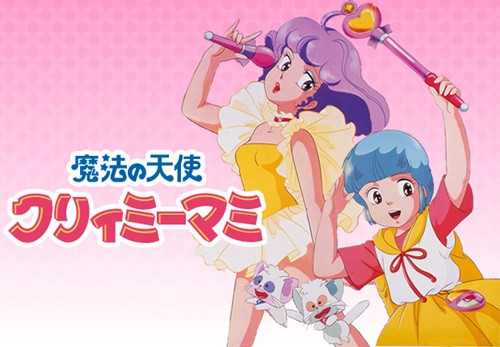
Welcome back to my occasional, completely unscientific, very self-indulgent look at the evolution of the magical girl subgenre! In my first post, I said that the subgenre can be loosely divided into three generations, starting with series like Sally the Witch and Majokko Megu-chan in the ‘60s and ‘70s. In this post, I’ll describe the second generation of magical girls: the new crop of shows starting in the early ‘80s that added some interesting elements that would transform the subgenre. Come join me below the break, gentle readers!
First, a quick recap. When talking about such a specific segment of pop culture, it’s helpful to have a definition to narrow one’s focus and keep things on track. In my first post, I attempted to define the magical girl subgenre as best I could; what I came up with was a series in which the main character(s) are girls, typically teenagers or pre-teens, who have access to magical or otherworldly abilities in what is otherwise a normal, real-world setting, which are used in conjunction with personal strengths and virtues to solve problems and/or achieve their goals, and which they must keep concealed from other people who aren’t in on the secret. Again, it’s not the most scientific definition—it’s a pretty broad net, including some works it probably shouldn’t and excluding a few it should—but it’ll do for this analysis.
Series like Mahoutsukai Sally and Majokko Megu-chan in the ‘60s and ‘70s were popular, running for multiple years and getting translated into other languages and spreading to other markets, but compared to other series they were modest successes. They didn’t have the cultural impact and staying power of other series from Toei around the same time—Cyborg 009 or GeGeGe no Kitaro in the late ‘60s, or Mazinger in the early ‘70s. And while Toei kept periodically making magical girl series—for example, Mahou Shojo Lalabel in 1980—the formula did not substantially change. The second generation of magical girl would come from a different studio, a newer contender in the world of anime: Studio Pierrot.
Toei Animation was (and is) one of the original giants of anime, having been founded in 1948. Studio Pierrot was founded in 1979 by former employees of other studios, and was trying to make a name for itself. It had already hit upon a pretty successful franchise with its adaptation of Urusei Yatsura in 1981, and was starting production on a number of new series. (Urusei Yatsura also sort of fits the “magical girl” definition, and has proved one of Pierrot’s most enduring and beloved properties, but I’d argue that it’s not nearly as important in the history of the subgenre as the series I’m about to describe. Material for a future post, I suppose.)
For one of these new series, Pierrot decided to use the strategy of “media mix,” an idea that’s been around in Japanese pop culture since at least the 1960s but which had only recently acquired a name. To quote Anime’s Media Mix: Franchising Toys and Characters in Japan by Marc Steinberg, media mix is “the development of a text across numerous media, among which anime plays a key role in popularizing the franchise; the dependence on other incarnations to sell works within the same franchise; and the use of the character as a means of connecting these media incarnations.” Basically, the idea is to build a franchise by using characters or ideas across multiple media, something that would reach perhaps its ultimate form in the Pokemon franchise a decade later. In this case, Pierrot would promote the music of a newly-acquired idol singer, Takako Ota, by making her the voice of the main character in a new anime series, Magical Angel Creamy Mami (Mahou no Tenshi Kurimi Mami), which premiered in July of 1983.
The “idol” is a specifically Japanese celebrity type, a young female starlet who generally appears on TV shows, in magazines, and especially in pop music. They’re usually presented and sold on the strength of their cute, pure, “girl next door” image, which means that their image is tightly controlled and heavily managed. It’s sort of the Hollywood idea of the “ingenue,” turned up to eleven and corporate-controlled. Now, if you remember, in my first post I noted that you can trace the development of the first magical girl series directly to the American sitcom Bewitched. These shows were putting their own spin on a fairly simple narrative: a girl with magic powers in a mundane world, dealing with simple problems and the occasional, unthreatening, cartoonish villain. In the same vein, you can trace the development of the second generation of magical girls to the introduction of this new pop-culture figure, the idol.

In Magical Angel Creamy Mami, Yu Morisawa is a normal 10-year-old girl, until the day she helps a small alien in his giant, invisible spaceship. For her help, she’s granted a magic wand with a variety of ill-defined powers and two helpers: talking cat-like creatures named Negi and Posi. Yu uses her powers to transform into a glamorous 16-year-old version of herself, who is quickly discovered by a record company and turned into a pop star by the name of Creamy Mami. She must navigate the demands of stardom while also occasionally solving strange magical problems and helping her friends.
I can’t claim to have any special insight into the minds of the show’s creators, but it seems pretty clear to me that Creamy Mami was tailored to fit the image of Takako Ota specifically, and the pop idol in general. The idol must be fresh and innocent even while being perfectly at ease with the demands of celebrity—both naive and media-savvy simultaneously—so our heroine is ten years old, but able to transform into an older, more mature form. She must be talented, but not seem ambitious—she must seem as though she has been plucked from her home without any preparation or training—so Yu is literally discovered by accident and pulled on-stage without even knowing she’s expected to sing, and uses magic in order to perform. The lengthy process of makeup and wardrobe is simplified into a glamorous transformation sequence: instant beauty, no hard work required! The idol is part of a massive pop-culture machine, but must seem like a completely ordinary girl who is never pressured by stardom, so the series has a hefty dose of comical magic antics and wacky side characters without any major consequences for our heroine. (The only recurring antagonists in Creamy Mami are a rival singer who resents the new, younger, cuter Mami, and an unscrupulous paparazzi named Snake Joe.) The overall premise of the series, with our main character being an idol herself, meant that Takako Ota’s musical talent was heavily featured, with one of her songs in the course of most episodes, in addition to both the opening and ending themes.
Many of the elements of the modern magical girl already existed prior to Creamy Mami—for example, transformation sequences were a part of series like Fushigi na Melmo and Himitsu no Akko-chan, as was the main character being a normal girl given magic powers rather than an inherently magical girl, and the cute funny sidekicks have been around since as early as Ribon no Kishi—but I would argue that they acquire a new importance and resonance when combined with the image of the idol. The glamor and pageantry of pop culture synthesizes nicely with the fantastic elements of the magical girl, while the dual nature of the celebrity—and in particular the idol, expected to be both untouched child and glamorous star—becomes something literally otherworldly, an amazing other self given by a being from the sky. By choosing a pop idol as both the main character and chief voice actress for Creamy Mami, Studio Pierrot had created a fusion of pop-culture archetypes that would become a huge success. The second generation of magical girls had begun.

Creamy Mami ran for 52 episodes and several original video animations (OVA), proving quite popular for the new studio. It finished in June 1984, and Studio Pierrot immediately followed up with similar series, each lasting for about a year: Persia the Magic Fairy (Mahou no Yosei Persia), Magical Emi the Magic Star (Mahou no Suta Majikaru Emi), and Pastel Yumi the Magic Idol (Mahou no Aidoru Pasuteru Yumi). Each of these series had the same basic premise—young girl is given some kind of magic power by a magical being and uses it in her otherwise normal life—although surprisingly, despite the success of Mami (and the title of Yumi), none of these later series re-used the premise of the character being a pop idol.
(I hear some of you cry: “That’s it? Four series, each a year long, all from a single production company? That’s what you call a generation?” And it’s true! By the standards I lay out, the second generation of magical girls is extremely small. But I would say that these four series, Mami in particular, are crucial to the history of magical girls. Think of this as a vital transitional period for the subgenre, a relatively brief moment in pop culture that would soon be superseded by newer, more popular works—the equivalent of Archaeopteryx linking dinosaurs and birds, these series bridge the gap between Sally the witch girl and Sailor Moon. Additionally, I’m mostly talking about series and developments in chronological order; while this period in the mid-80s is the birth and peak of the second-generation magical girl, there have been later series that fit this category.)
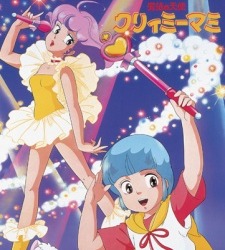
So what are the new elements added by the second-generation magical girl? As I see it, there are two: first, the ordinary girl and the magical girl are two distinct characters which require a visible transformation. As I said in the final paragraph of my first post, while the magical girl has always had to hide her abilities, only starting with this generation does she hide her identity behind another full-fledged persona. The opening credits of Mami show Yu and Mami’s faces spinning around like opposite sides of a coin. Creamy Mami is in fact even more separate than most other examples in the subgenre; not only does she look completely different from Yu, she is specifically described as six years older than her “normal” self. Again, this is the archetype of the pop idol given a fantastic spin; the “celebrity” is a different person from the “person.” (Think, for example, of Hannah Montana!) Connected to this first point, second, an emphasis on costume, pageantry, and physical transformation into a more glamorous self. This is also at least partly due to improvements in animation allowing for more impressive spectacle, but the creators certainly made good use of it. Mami is dynamic and colorful, obviously far more so than its black-and-white precursors. It is also more toyetic than previous magical girl shows, par for the course for a media mix show; Mami uses a magical compact and wand to transform, plastic replicas of which could be bought as accessories, and stuffed animal versions of her fairy companions were available as well. (To be fair, Mami was hardly the only series from this period to be merchandised so heavily.) To what degree the pageantry influenced the desire to make toys, or vice versa, I can’t say, but they certainly go hand in hand from this point on.
There are also elements of this generation that have become staples of magical girl series—the cute sidekicks, the magic trinkets—but I think those are not truly essential, or rather, that what is essential about them is included in my second point above. To put it simply, the second-generation magical girl is surrounded by more stuff—a wand, some talking cats, magical accessories—all of which add to the pageantry (not to mention the merchandise).
There’s another element which I don’t think is necessary for or specific to the second-generation magical girl, but which also deserves a mention: Mami and other shows are aimed at a slightly older audience than Akko-chan or Sally, and the characters are children who often have to navigate adult worlds. Mami is in the music business; the main character in Magical Emi is a young girl who participates in her family’s magic shows. Even in shows where the character is not specifically participating in an adult sphere, they still find themselves in the position of having to act like adults: in her very first episode, Persia tries out her new magic by transforming into a policewoman and tricking her friends. These characters have a child’s perspective on adult problems, and while they can sometimes help the adults in their lives, they are still often flummoxed by the mysteries of the grown-up world. I think this is largely a matter of changing pop-culture expectations, a recognition that older girls—relatively older, that is, pre-teens and teenagers—were watching these shows, and would want to see characters closer to their own age, or at least dealing with similar problems. Again, I don’t think this is a defining feature of this generation of magical girls, but it’s something that will come up in other series and which should be noted.
That covers the second generation of the magical girl subgenre! And boy, are my fingers tired. Join me for the third installment, in which we finally reach the series that would define “magical girl” in both Japan and the rest of the world, and which would leave an indelible stamp on the genre—and anime as a whole—that has lasted to today. You know the one I mean.
#magical girl#magical girl history#mahou shojo#creamy mami#studio pierrot#scsg!#persia the magic fairy#magical emi the magic star#pastel yumi the magic idol
118 notes
·
View notes
Text
The Top 10 Books I Read in 2017

Funny how I wasn’t able to read as much books as I wanted to despite the fact that I wasn’t really doing anything for two and a half months. I was able to read 25 books in 2017, just enough to hit my Goodreads 2017 Reading Challenge. Usually, I go over my pledged number of books. This was the only time, if I remember right, that I wasn’t able to surpass my reading challenge.
Finishing that challenge was an effort, mind you. I finished reading the last book for 2017 on December 30, and i pushed myself just so that I can finish the challenge. I blame all this slow reading to Miss Peregrine. If you’ve read my thoughts on that book, you’d know why.
Going back to the real purpose of this blog... Of the 25 books I read this year, 15 were considered for this list. I know that’s quite a lot, but that’s good, in reality. That means I'm now more careful on choosing which books to read.
The sad part about this—similar to my dilemma last year—is that I have too many books that I want to include in the list. It’s with great regret that I won’t be able to put them in here even if I wanted to.
Anyway... here it goes.
*The books in here are included regardless of their genre, release date, and author—whether they be Filipino or international. As long as its a book that I’ve read within the given year, they can be considered for the list.
(Scores are on a scale of 1-5, inspired by Goodreads’ rating format)
10. A Hat Full of Sky by Terry Pratchett (2005)
SCORE: 4.250
This is the second book in Pratchett’s Tiffany Aching series. I really loved the first book and I’m so thrilled that whatever it is I liked from the first one continued with this—at times, even better. But I’m a nothing-bests-the-original type of person, so the first book scored higher for me. You’ll see it further on this list.
9. The Inexplicable Logic of My Life by Benjamin Allire Sáenz (2017)
SCORE: 4.275
One thing that t I really love about Sáenz‘s books is the tone of his writing. It’s utterly simple, yet very poetically beautiful—which for me makes it very quick and easy to read.
His other book that I read, Aristotle and Dante Discover the Secrets of the Universe, is one of my favorite books. Having known that he recently released a new book, I din’t mind that it’s still only available on hardbound, I immediately bought it when it came out. I had high expectations for it.
This book gave me the same feelings when I read Ari and Dante, though it wasn’t as effective. Toned-down would be a good word for it. There are parts where it would hit you right on the heart. Ironically, this is what the books is all about—love. It’s about all types of love, even if the book never had an ounce of romance in it—maybe just a little bit.
8. The Wee Free Men by Terry Pratchett (2003)
SCORE: 4.330
The story in itself is very similar to a fairy tale and you can even identify a few references grabbed from the classics. But unlike those old tales of fantasy, this one is void of all the atrocities and rather has common sense and unwavering cleverness—not to mention, an ample amount of humor.
One thing that I also love about the book is that all characters are very likable and have distinct personalities—even the tertiary and background characters have personalities, it’s insane!
See full review
7. The Girl Who Drank the Moon by Kelly Barnhill (2016)
SCORE: 4.345
I always love a book with amazing characters who have deeply rooted motivations. This is what I adored about this book. It felt like all the characters have valid reasons why they were doing the things that they did in the story, and the way it just pushed the plot forward and how everything went to be is just enchanting.
This is a book meant for children but it can certainly be enjoyed by any person of any age—except for the toddlers who can’t read, obviously. This book is for the people who looooove fantasy. I got into reading because of fantasy books—hello Chronicles of Narnia—and this creation by Barnhill is a unique jewel in the midst of middle grade to young adult novels which nowadays are starting to sound too similar to one another.
6. The Perks of Being a Wallflower by Stephen Chbosky (1999)
SCORE: 4.405
I had setbacks when I decided that I wanted to read it. It was on the bottom of my I-plan-to-read-list primarily because I’ve already watched the film adaptation and I’m worried that I wouldn’t appreciate the book that much since I already know the story and thought that it would take away too much of the book’s charm.
BUT I WAS WRONG.
I didn’t really plan on reading it but on June 10, when I was alone in our house and wanted to do something so that I won’t get bored, I went out to find a book and eat at a local café. Turns out, this was the cheapest book I found that actually pulled my interest.
Anyway, the book—much like the film—is very touching and fun to read. Like, I never would’ve thought that the book was written during the 90′s because it gave me the modern YA feels, like it totally blended in with the books that I love reading.
It gave me the feels. You know, the weird feeling in your heart when you read a book or watch a film. It was very prevalent in this book.
5. The Name of the Wind by Patrick Rothfuss (2007)
SCORE: 4.475
I got this book as a Christmas gift from a fellow Star Wars nerd. She loved it that’s why she gave me a copy. Basing from the reviews it got from Goodreads, it is an amazing book. AND IT LIVED UP TO MY EXPECTATIONS.
I just love how the characters are fully made up… although some feel like cardboard cutouts, I don’t mind. I mean, they’re very minor characters. At most, the main characters are very interesting.
It’s a good substitute to those who are reading the A Song of Ice and Fire series. It has the same amount of epicness, same amount of characters, ample amount of secrecy and mysteries, but thankfully not as grandiose and confusing\ as GRRM’s (yeah, as much as I love the ASOIF books, sometimes it goes a little too far).
It’s a really thick book which I would normally get bored of reading in the middle, but that didn’t happen.
4. Simon Vs. the Homo Sapiens Agenda by Becky Albertalli (2015)
SCORE: 4.605
It is a truly wonderful book that proudly represents the LGBTQ community.
I love how Albertalli wrote it in such a sarcastic tone, and it reminds me of the time when I have a similar tone in writing—the time before I started doing all those melodramatic stuff.
There are times in the book that I almost wanted to cry.
Also, it’s one hell of a page-turner. I couldn’t stop reading it! The book laid open on my desk at work and I occasionally read a few pages every now and then. I wanted to know how it ends so badly.
I also love the way that the story is also very engaging to the readers, like the way that you want to share with Simon’s adventure and search for the mysterious identity of Blue. I had speculations. I said, if this would be him, the story would be stupid. If this would be a girl, it would be disappointing (and Will Grayson-ish). If it was this other characters, it just doesn’t make any sense. But there’s this minor character who would probably fit. AND I WAS DAMN RIGHT. I predicted it but it was good, because all the other options would make a really bad story. I predicted it but it was good, because if I was the one who wrote the story, I would’ve written it the same way.
3. Scythe by Neal Shusterman (2016)
SCORE: 4.610
This is only my second Neal Shusterman book and I think I’m starting to become a fan. In this novel, he created a world that is so thought-provoking, and he made it distinct among the over-crowded dystopian novels of the recent years.
I recommend this to anyone who loved reading The Hunger Games—or just to anyone who loves to read—because it gives you the same emotions. Different story, same feeling. It will surprise you. It will scare you. It will excite you. And at a certain point, it will crush your heart.
See full review
2. We Are the Ants by Shaun David Hutchinson (2016)
SCORE: 4.615
This book portrays the message that no person in this world has a perfect life. We are all flawed, and we all have reasons to be unhappy.
I was heavily impressed at how Hutchinson was able to incorporate that factor in all of his characters. That is what I like most about this book. Anyone in the world who loves to read may be able to have a connection to it—naturally, everyone of us has imperfections and we can empathize on the characters because of that.
I love the little sci-fi things that are enclosed in-between chapters, including the main premise that Henry (the main character) is abducted by aliens. And I love the mystery by the end as to whether or not these abductions are true or just a figment of Henry’s imagination. *Spoiler alert, if you’re wondering how this part of the story is resolved… it was never resolved*
He’s depressed and he probably has anxiety so this could possibly his mind’s manifestations to cope up with his life. This real-unreal phenomenon kinda reminds me of A Monster Calls… you know, you’re not sure if whether or not the Monster was real or not.
This factor adds a little interaction with the readers as it forces us to use our own creativity and rely solely on our imagination on how this all adds up. It can be true. It cannot be true.
And also, the book has these occasional moments that will really crush your heart. You know how much I love books that do that to me.
AND THE AWARD FOR THE BEST BOOK I READ IN 2017 GOES TO...
1. The Kite Runner by Khaled Hosseini (2003)
SCORE: 4.630
I’ve seen this book on store shelves a couple of times and I always overlooked it. Probably because the cover isn’t very much appealing to me, and I’m not a usual fan of books that center on war themes, especially those that are set in the middle east.
So when I finally paid attention to it, and saw the good reviews it had on Goodreads, I said to myself. “I effin’ need to read this.”
Also, one of the reasons why I decided to read it is for this list. At the time, this list was dominated by YA novels, all of which have LGBTQ themes in them. Had We Are the Ants topped the list, for three years straight, YA-LGBTQ books bagged the top plum. I have nothing against these type of books—I like them, obviously—but I thought that I just need some sort of variety.
Going back to this book... this has left me scarred. There are scenes in the book that I will never, ever be able to forget. Like there were scenes that I read while I was inside a bus on my way home, and I had to stop reading because I didn’t want people to see me crying in public. Unfortunately, I still cried.
For me, this book tells us that life will always be full of sh*t. You may have your good days, but it will always try to test you. Other than that, it tells us that there are people in this world who would die for honor, and for love.
I will no longer tell anymore about this book. I suggest that you should just read it. I highly recommend it. Definitely one of my favorites.
Other books considered for this list were I Wrote This for You by Iain S. Thomas, Fangirl by Rainbow Rowell, Chasers of the Light by Tyler Knott Gregson, Kids of Apetite by David Arnold, and Everything, Everything by Nicola Yoon. I really wish that they were in the top—especially the poetry books by Thomas and Gregson, that would’ve been a first—but I only need ten and 2017 was just crowded with good books.
I read better books this year than the past year. You can just tell from the ratings. The tenth place on this was already on 4.250—I had to include a third decimal to break the ties, that’s why the scores are so close. Last year’s tenth was at 3.68, and the first book to actually go higher than 4.250 was All the Light We Cannot See with 4.32, last year’s fourth placer. Last year’s first placer— I’ll Give You the Sun which scored 4.57—was edged out by this year’s with 4.630.
I wish I would still have the same dilemma for 2018. I know it’s a problem, but it’s a good problem.
Happy book-reading this 2018!
1 note
·
View note
Text
Module - Animation Context
I’ve written up a large portion of my essay, although I haven’t had my essay critiqued yet either. I plan on reverse engineering the layout and sourcing/figuring system used in the essay Animation Best Practice (2016) in order to apply it to my essay.
Diving into Disney’s Soup of Potential Corruption
Cameron Davison
The University of Salford, UK
Point 1
The Walt Disney Company’s recent acquisition of 21st Century Fox, or 20th Century Fox, one of the oldest major film studios still alive today, marks a significant time in the film industry. For the first time since the decay of Metro-Goldwyn-Mayer in the 1980’s (Scott Mendelson, 2019) a major film studio/company has ceased to exist as an individual entity, being consumed by one of the largest behemoths of a company in the film industry, The Walt Disney Company (Todd VanDerWerff, 2019). The Walt Disney is one of the largest film companies in the industry, holding many of the most iconic franchises under the belt, including Star Wars, Marvel and its most famous comic book characters, and now Fox entities such as The Simpsons, Family Guy, not to mention a plethora of Fox owned movie franchises such as Avatar. With the acquisition of 20th Century Fox, the Disney company stands as one of the largest companies within the entertainment industry, a monolith comprising of numerous large companies and franchises amalgamated together, towering over its competitors. Both companies involved in this merger have long and storied histories. Disney has made countless successful and iconic films throughout the past century, having evolved from being a small animation studio run by one man, Walt Disney himself, into a media empire. The company today now owns a significant number of companies and properties, having acquired many other entertainment companies through its long history including Pixar, Marvel Studios, Lucasfilm, on top of numerous TV channels and theme parks (Mendelson, 2019). The Walt Disney company accounted for 26 percent of the box office revenue in 2018 (Peter Bart, 2019), with movies such as Avengers Infinity War and Incredibles 2. Meanwhile, 20th Century Fox is one of the longest surviving film studios from the golden age of Hollywood, having emerged around either 1915 or 1935, the studio’s beginnings being a bit cloudy. The company has been a prominent film studio throughout the intervening years between then and now, having produced iconic and well-known films throughout the past century: Titanic (1997), Avatar (2009), Bohemian Rhapsody (2018) to name just a few recent successes, not to mention TV networks. In the past year, aside from Deadpool 2 and Bohemian Rhapsody, 20th Century Fox didn’t have the best box office run in 2018 (McClintock & Bond, 2019). The company has traded hands amongst many interesting characters, from oil tycoons like Marvin Davis to Rupert Murdoch, a primarily a news mogul (Bart, 2019). Both of these companies are important and long-standing fixtures of the film and entertainment industries, having endured throughout the decades. Both of them are largely successful and continue to make movies that are very successful around the globe, which to many makes this merger all the more intriguing, given that the merger involves one very large company absorbing another one into its collective mass. A large portion of movie goers, film critics, and industry people alike are concerned for the ramifications of this merger.
Point 2
The merger was first confirmed in December of last year (Dana Feldman, 2019), and since then there has been a lot of discussion surrounding the potential layoffs from Fox’s end of the merger, with upwards of 4,000 layoffs being expected after the transition, so that the Disney Company can save $2 billion in cost savings (Georg Szalai, 2019). Many executive producers and lower level employees are likely to loss their jobs, with Fox’s studio lot reported having become a lot quieter in the lead up to the merger, with the chairman and CEO of 20th Century Fox Stacey Snider being expected to step down from her position after the deal is finalised (McClintock & Bond, 2019). Out of Fox’s 22,000 employees across the globe, approximately 7,000 of them are expected to soon be joining Disney’s 201,000 employees (McClintock & Bond, 2019) and factoring layoffs on Disney’s end, the total number of casualties expected to result from this merger are 10,000 employees being laid off (VanDerWerff, 2019). What's interesting to note in this merger is not only are the employees at Fox are at risk of losing their jobs, but executives, highly paid and valued employees, are also at risk, with one marketing executive having “sent his most cherished belongings to storage that day just in case he was forced to exit abruptly” (McClintock & Bond, 2019). Following the initial announcement of the merger, originally being priced at 52.4 billion dollars, came a bidding war between the Walt Disney Company and Comcast, owners of Nickelodeon and NBCUniversal, which began when Comcast gave a counter offer of 65 billion dollars (Cynthia Littleton, 2018). By the end of this bidding war, Walt Disney won out with a 71.3 billion dollar deal, in which not only would Disney gain 20th Century Fox, FX networks, National Geographic Partners, dozens of international channels and a majority stake in the online streaming service Hulu, if would also gain control of one of the broadband companies in the U.K., and Europe, Sky, with Fox not only already owning a 40 percent stake in the company, but had also been working towards gaining the remaining 60 percent at the time Disney first announced the merger (Littleton, 2018).

I took the time to find more sources for my essay, after being given a number of things I should improve. The main points can all be summed up together as “How does this relate to animation specifically, and what first-years can apply, or at least gain valuable knowledge from?”.
Rusty Gray (Early 2015), How Small Studios can be your BIG break, Skwigly
This article, part one of a series of articles, was written by Rusty Gray, the title of the article being How Small Studios can be your BIG break (2015). The article is about an animator discussing his early experiences in his career, how he wanted to be an animator at a massive company such as Pixar, but ultimately found working for a smaller studio more enriching. The article is based upon the personal experiences of the writer, as well as quotes from larger figures in industry. The article was published in early 2015, and despite its age it is relevant as it covers animation and the career path of an animator, and specifically it tackles the notion of having to work for large company like Disney and Pixar in order to be a “success”. The article is based upon the personal experiences of the writer, in tandem with quotes from prominent figures in industry. The article was published by Skwigly Online Animation Magazine.
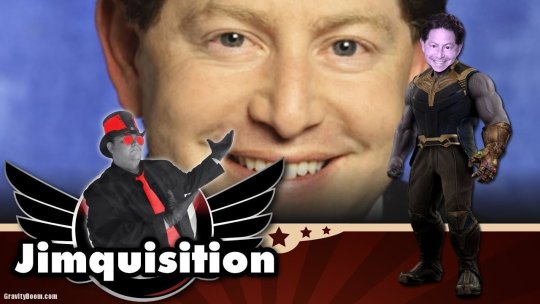
Jim Sterling (2019), EA and Activision CEOs Among The Most Overpaid in America, YouTube
This video, published by Jim Sterling, is titled EA and Activision CEOs Among The Most Overpaid In America. This video, while mostly covering recent news in the video game industry, makes an interesting point about mistreatment of workers in creative- and general- industries, making a point about the threats of lay-offs potentially hindering creativity and work ethic. An excellent example of this is brought up, when the game company Nintendo was struggling financially a few years ago, its CEO Satoru Iwata took a 50% pay-cut to his salary. The video bases its information on news articles and largely speculation, the point of the video being to state an opinion based upon recent news and information. The video is current, being released on the 26th of February this year. The video is relevant as it covers aspects of business and its effect on the creative industries, while basing its information on articles. The purpose of the video is to interpret information and convey the creator’s opinions on business practices in the creative industries.

Paul Bond & Georg Szalai (12th December 2017), Fox-Disney: Now Get Ready for the Power Struggle, The Hollywood Reporter
This is an article written by Paul Bond & Georg Szalai, titled Fox-Disney: Now Get Ready for the Power Struggle. The article discusses the early stages of the merger, revealing what was happening and why, along with how much Disney was taking versus how much Disney was leaving behind. The article is based upon official information and speculation from industry insiders, mainly information released to the press from the companies involved. The article was published on 12th December 2017.m It’s still relevant, however, as it covers the topic of the merger. It was published in the Hollywood Reporter, its main purpose being to inform, although there is also a lot of opinion espoused by the article.
0 notes
Text
[1/2] Enstars: B’s-Log March 2017
Released in January 2017.
Unit Song CD 2nd Series Vol.9: fine Cast Interview
English lyrics are not yet up on the wiki, but I’ll eventually refer from other sources!
[edit 6/5/17: I made a mistake in Midorikawa’s Q3.
× Wataru is the one who sings, and if that’s the case I wanted them to let me sing that line.
○ Wataru isn’t the one who sings that line, but if that’s the case I wanted them to let me sing it instead.
The line “Hibiki wataru kassai o” is sung by Yuzuru and Tori. (source: actual CD)]
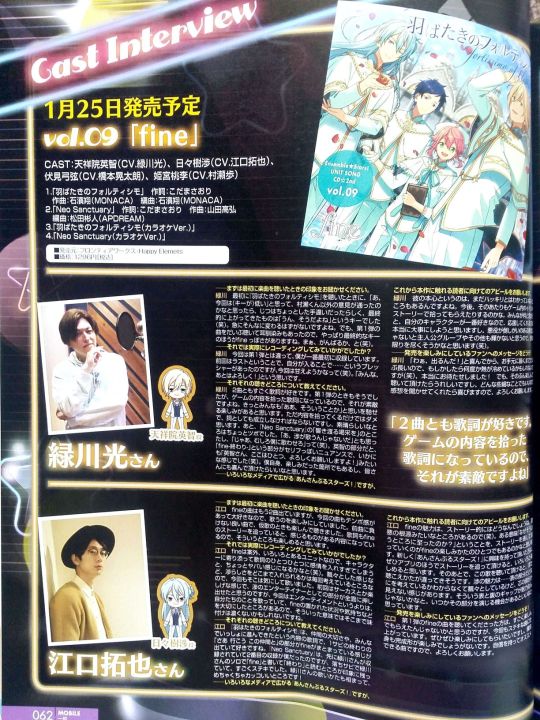
Hikaru Midorikawa (CV of Eichi Tenshouin)
Q: Firstly, please tell us about your impression on the songs when you first listened to them.
Midorikawa: When I first listened to Fortissimo of Fluttering Wings, I thought, “Oh, this time (the key) is low.” I thought maybe all but Murase-kun’s opinion got through, but it turned out it was a slip up. In the end, the finalized key made me go, yeah, this is how it should be (laugh). There’s no way it would change so drastically all of the sudden. But it’s also because I’m already so used to the songs from the first series, the finalized key gives out more of that fine vibe after all. So I thought, well, I guess I have do my best (laugh).
Q: Then how did the actual recording go?
Midorikawa: Unlike the first series, I was the first member to go into the recording. In the first series, I was the last and the fact that I had to follow up the others put me on a pressure. So this time I guess I’ll take advantage of the opportunity (laugh). I can experience this feeling of “Everyone, I’ll leave the rest to you!”
Q: Please tell us the appeal of each song.
Midorikawa: I really like the lyrics of both songs. Just like the first series, the lyrics take the content from the game, which is great. I bet everyone will enjoy the songs by connecting the dots. But the lyrics can’t simply write out the content – it has to establish itself into proper lyrics of a song. I think that’s wonderful. Also, I cracked up a bit at the line “Hibiki wataru kassai o” in Neo Sanctuary. Wataru isn’t the one who sings that line, but if that’s the case I wanted them to let me sing it instead (laugh). Speaking of Eichi’s lines, “fine (the end)” [1] has a nuance of a spoken line, and indeed it felt like Eichi had to do the job for this one (laugh). As for myself, it was a line I was looking forward to sing as well, and I hope it can please everyone.
Q: Ensemble Stars has been extending its reach through appearances in various kinds of media. Could you promote the series to the readers who have not yet been exposed to it?
Midorikawa: I think there are times you may think his true feelings are still somewhat unclear. I wonder if it will be addressed in the future event stories. No matter what people say, I like my own character the best, so I want to really treasure those who are giving their support. I also think if a villain isn’t worth defeating, the protagonists and the others won’t shine so brightly, so I thought I should also reach the very limits of the evil (laugh).
Q: Please give a message to the fans who are looking forward to the release!
Midorikawa: There’s a long time between the excitement of knowing a CD release is planned until it’s actually released, so the heat of that excitement may be cooling down, (laugh) but thank you so much for waiting! But to make up for that, I hope you’ll enjoy listening to it, and it’ll make me happy if you can tell me your thoughts no matter how small it is. So please give us your support.
---(t/n)---
1. “Owari”, the quiet bit right before the last chorus.
Takuya Eguchi (VA of Wataru Hibiki)
Q: Firstly, please tell us about your impression on the songs when you first listened to them.
Eguchi: Fine has released two songs. But this time I love how you can feel the beat in the songs, so I was looking forward to singing them. They are good songs that won’t lose to their predecessors, and I enjoyed listening to the demo. If you have been following fine’s stories, the lyrics will take you on a ride, so I think that’s something you can enjoy.
Q: Then how did the actual recording go?
Eguchi: Unexpectedly, fine is a unit that has a lot going on. So if I were to get more in-character and put too much emotion into every single line, it may be a bit dangerous (laugh). Things such as his carefreeness, or how much Wataru’s character should be put into the singing are what I think about every time, including this time. The previous series was fun with its circus theme and the like, and I think the entertainer side of Wataru was able to be put under a spotlight. But this time, rather than to entertain, they’re singing about themselves and they value things such as fine’s established situation and feelings. In that sense, the ‘flavoring’ may not be that strong this time.
Q: Please tell us the appeal of each song.
Eguchi: The lyrics in Fortissimo of Fluttering Wings talk about the importance of comrades and their wish to move forward with everyone. At the end of the first chorus, there’s a line “Now let’s go, with these friends” [1] which feels like fine is brought together and I like it. As for Neo Sanctuary, I was the second to record after Midorikawa-san, and in the chorus before climax, Midorikawa’s solo line, “fine” that was read as “the end” [see Midorikawa’s t/n #1] left a deep impression – it was really wonderful. Combined with Midorikawa-san’s way of singing, it’s a really awesome part!
Q: Ensemble Stars has been extending its reach through appearances in various kinds of media. Could you promote the series to the readers who have not yet been exposed to it?
Eguchi: Story-wise, I wonder what fine’s charm is? I mean you can say they’re the roots of all evil (laugh). I think the way you can enjoy fine is how you follow them along with the story, as you ask yourself how they ended up that way. For those who had only recently taken interest in Ensemble Stars!, I think you’ll be able to find all sorts of fun if you follow the story. If you listen to these songs again after that, you may have a different point of view. Wataru’s charm… On the surface, he seems carefree and you can’t tell what he’s thinking, but I also think you can’t really see his core. I think the gap between his outside and inside is his charm. I hope someday there’ll be opportunity where I’ll be able to act out that part of him.
Q: Please give a message to the fans who are looking forward to the release!
Eguchi: I think those who listened to fine’s songs in the first series were able to have a lot of fun, but this time we also have wonderful songs. I really want you to look forward to them, and I also can’t help but look forward to the finished product. They’re songs I can recommend with pride, so please check them out.
----(t/n)---
1. The romaji is “Saa ikou, kono nakama to”
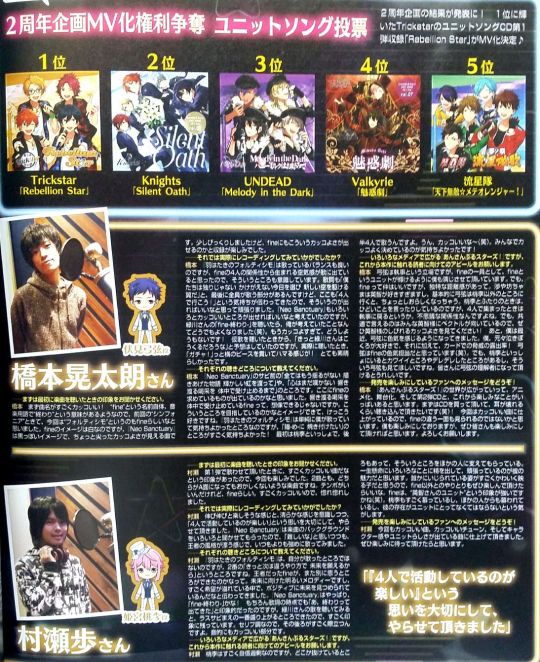
Koutarou Hashimoto (VA of Yuzuru Fushimi)
Q: Firstly, please tell us about your impression on the songs when you first listened to them.
Hashimoto: Firstly, the song names are so cool! Apparently the name “fine” also means “the end” in music term, so I thought it’s very like them to have “Fortissimo” this time, following “Symphonia” from last time. Fine’s image is the color white, but Neo Sanctuary has a dark image and you can see its coolness that has a slight edge to it. This song was a bit unexpected, but the moment I knew fine can also bring out coolness like this, I was looking forward to the recording.
Q: Then how did the actual recording go?
Hashimoto: The vocal balance in Fortissimo of Fluttering Wings is nice, but in it there’s also an atmosphere that is brought out from the relationship among the four members, which is something I kept in mind while singing. In the parts “We are not alone | We chose the irreplaceable present | These are new wings that fly across the new sky” [1] and also where everyone sings together at the end, I could also feel they’re saying, “Let’s go with the four of us!” – I hope I was able to show that in my singing. I was also thinking of bringing out lots of cool points in Neo Sanctuary, but after listening to Midorikawa-san’s “fine (the end)” [see Midorikawa’s t/n #1], what I was thinking didn’t matter anymore (laugh). It was just so cool, there’s nothing I can do about it! Even when I listened to the demo tape, I tried to predict how Midorikawa-san would handle that line, but after actually listening to it, you are struck with this addicting feeling that surpasses even that of taking pictures with a side peace sign! It’s really wonderful.
Q: Please tell us the appeal of each song.
Hashimoto: In Neo Sanctuary, it would be the parts before the chorus like “It will no longer be shaken by anything | This story that was made | It crosses the glittering rainbow” [2] and “Our hearts still refuse to lament | This resounding applause | We will accept it with all we have.” [3] I think these parts show what fine is pursuing. You can picture the scene of fine accepting the resounding applause with all they have. I thought lines like these may be what they’re after, and I like it quite a lot. As for Fortissimo of Fluttering Wings, it simply felt like I was the one who sang, and it felt nice. The line “I want to burn the scene into your eyes” [4] felt so good to sing! At first it was just [Yuzuru] and Tori, but after that the four of them sing the line together. Yeah, it’s so cool, isn’t it? (laugh) It felt good being able to head out with style with everyone.
Q: Ensemble Stars has been extending its reach through appearances in various kinds of media. Could you promote the series to the readers who have not yet been exposed to it?
Hashimoto: Yuzuru’s position is a butler, but as a member of fine, I intend to act as him so that fine can shine brightly. Fine members get along, but there’s this peculiar sense of distance. Wataru and the young master like Eichi way too much, and when Yuzuru is with someone other than Tori, he basically becomes a bit more modest. When he’s alone with Tori, he would say terrible things, but when the four of them are together he’s back being a butler, so I mean, it’s a mysterious relationship. But, if they have something in common it would be how everyone inclines themselves towards Eichi-sama. So please witness Eichi-sama’s mesmerizing coolness! Also, recently I have started to feel Yuzuru’s sensuality. I’ve always loved moles under the eyes, and top that with how much the cards exhibit the menacing atmosphere! I think Yuzuru is in charge of fine’s sexual appeal (laugh). But when he’s together with Tori, he shows his cute side and shows so much love, so I want you to observe that kind of Yuzuru too. It would be great if everyone can understand Yuzuru’s character.
Q: Please give a message to the fans who are looking forward to the release!
Hashimoto: The world of Ensemble Stars! is expanding, and I believe there are many things to look forward to such as anime and stage adaptations, and the second series of the CDs. First, I’d like you to purchase the CD and listen to it until your eardrums are torn! (laugh) This time we have cool songs, so I think you’ll be able to see a different side to fine. I’m looking forward to it, and I hope all of you feel the same. Please give us your support.
---(t/n)---
1. Bridge: “Bokutachi wa hitori janai | Kagegaenai kyou erabi | Atarashii sora wo kakeru tsubasa da”
2. Whole first prechorus: “Subete wa mou yuruganai | Egakiageta monogatari | Kagayakashii niji o watatte”
3. Whole second prechorus: “Kokoro wa mada nagekanai | Hibiki wataru kassai o | Karada-juu de uketomeru made”
4. End of first chorus: “Kono me ni yakitsuketai”. To clarify the next sentence after this, Yuzuru and Tori part Hashimoto is talking about is in the same chorus: “Hashiridashita tashika na Glory Days”
Ayumu Murase (VA of Tori Himemiya)
Q: Firstly, please tell us about your impression on the songs when you first listened to them.
Murase: When I sang in the first CD, I remember they were really cool songs, so this time I was looking forward to singing the new songs as well. As for the two songs, it wouldn’t be surprising to have either one as the A-side. The tempo is nice, but it’s still very like fine. They’re really cool, and I was enchanted by them.
Q: Then how did the actual recording go?
Murase: I kept in mind to sing with fun, carefreely and untainted. I’d also treasure the feeling of “the four of them are having fun working together.” I’d heard much of the background to Neo Sanctuary. While I thought it’s going to be difficult, I tried to sing giving out a wafting feel of a ruler and with more power than usual.
Q: Please tell us the appeal of each song.
Murase: In Fortissimo of Fluttering Wings, although it’s not my part, I think its appeal would be the line in the second verse: “Surely, next time we can use different means | To wish for a future.” [1] Fine is not a ruler anymore, but it seems like they have found something else. It has a bright melody that points towards the future, and it’s overflowing with hope. In the midst of that, I could feel that they are looking at the future with positivity. As for Neo Sanctuary, I guess it would be “fine (the end)”, after all! [see Midorikawa’s t/n #1] Of course from when I looked at the lyrics, I thought, “Ah, ‘the end’ came up” and it already left an impact at that time. But when I listened to Midorikawa-san’s singing, it’s right before the last chorus; it’s the most climatic part. So it left a really deep impression. It’s a spoken line, so it’s a great contrast to the part that followed. Sound-wise, it’s also a cool part.
Q: Ensemble Stars has been extending its reach through appearances in various kinds of media. Could you promote the series to the readers who have not yet been exposed to it?
Murase: Tori is overconfident, but he also has a careless side, and there are people who would keep him in check. He would put his energy and do his utmost best in all sorts of things, and I think that hardworking side of him is his charm. I think he’s a boy who will look adorable when getting bullied, so I hope you can enjoy his interaction with characters other than fine members as well. Fine has a strong impression of it being Eichi-san’s unit, doesn’t it? (laugh) Tori adores him very much, and there are also others who are also the same, so I feel his existence is a must in this unit.
Q: Please give a message to the fans who are looking forward to the release!ine
Murase: This time, we have songs that are cool with cool tunes, and bring out the feel of the characters and the personality of the unit. Please look forward to them as you wait for the release.
---(t/n)---
1. Second verse: “Kitto tsugi wa chigau yarikata de | Mirai o negaeru kara”
#ensemble stars#b's log#fine#eichi tenshouin#wataru hibiki#yuzuru fushimi#tori himemiya#hikaru midorikawa#takuya eguchi#koutarou hashimoto#ayumu murase#staff
46 notes
·
View notes